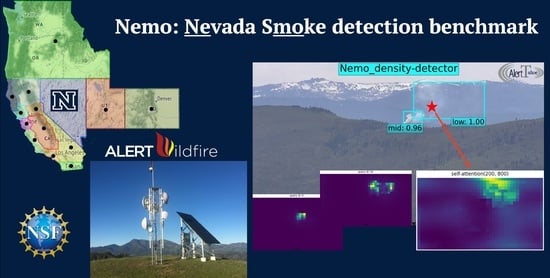Nemo: An Open-Source Transformer-Supercharged Benchmark for Fine-Grained Wildfire Smoke Detection
Abstract
:1. Introduction
1.1. Motivation
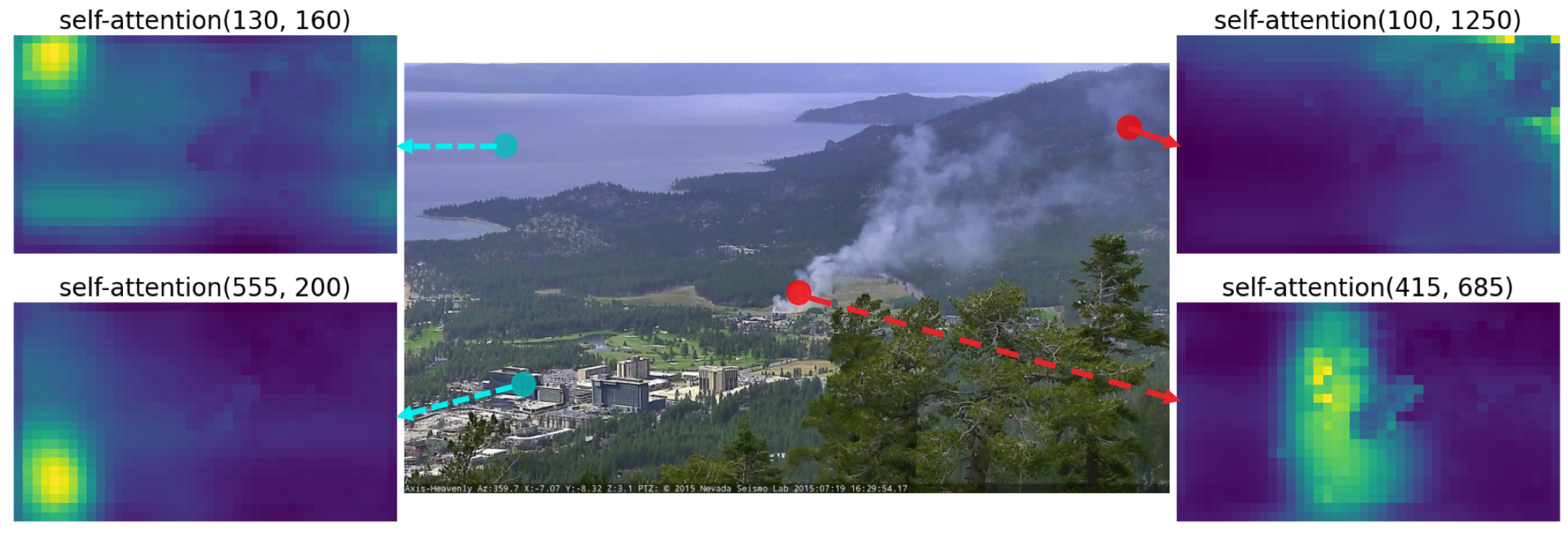
1.2. Challenges
1.3. Nemo: An Open-Source Transformer-Supercharged Benchmark for Fine-Grained Wildfire Smoke Detection
- We show that the self- and inter-attention mechanisms of encoder–decoder Transformers utilize long-range relationships and global reasoning to achieve state-of-the-art performance for wildfire smoke and smoke density detection. An example visualization of the encoder self-attention weights from a model we trained on our data is shown in Figure 1. This shows that even at an early stage of training (i.e., encoding), the model already attends to some form of instance separation.
- Additionally, our benchmark offers trained smoke detectors based on well-established and highly optimized object detection algorithms, namely Faster R-CNN with FPN [39] and RetinaNet [41]. The reasons for choosing these alternative object detection algorithms were their impressive results in incipient stage smoke detection, reported in a recent work [16], and to provide a comparison and context for our Transformer-based smoke detector. Our results based on numerous visual inferences and popular object detection metrics (i.e., mAP, PASCAL VOC, etc.) show that the encoder–decoder Transformer architecture performs better than the state-of-the-art ConvNets for wildfire detection.
- We also create additional dataset configurations, motivated by our initial results, which returned a relatively high number of false detections in a challenging set of empty images. We add collage images of smoke and non-smoke scenes. Our results show a significant reduction of false alarms for all models. We also created an alternative dataset, tailored to situations where the underlying object detection codebase does not support explicit addition of negative samples for training.
- Furthermore, we perform an extensive time-series analysis on a large test set, collected exclusively from the incipient stage of 95 wildfires [13,17]. From time-stamps recorded on the 95 video sequences and our detection results, we determined the mean time of detection after the start of the fire (i.e., mean detection delay, or latency). To the best of our knowledge, this is the largest analysis of its kind. Our Transformer-supercharged detector can predict wildfire smoke within 3.6 min from the start of the fire, on average. In context, we compared our results to 16 video sequences used in a similar analysis from [16]. We show that our model detects wildfire smoke more than 7 min faster than the best-performing model reported in the literature [16]. Our model was able to detect 97.9% of the wildfires within the incipient stage and more than two-thirds of the fires within 3 min. Since the majority of the smoke columns in the first few minutes of a fire are extremely small, far, and shallow, then by extension, we confirm that the proposed models are effective at detecting small fires. For instance, our model was able to detect objects as small as 24 by 26 pixels in an image of 3072 by 2048 pixels (6 MP). In relative terms, the correctly detected smoke object is 0.0099% of the input image, as shown in Figure 2.
- In addition, our Transformer-based detectors obtain more than 50% and 80% average precision (AP) for small and large objects, respectively, outperforming the baselines by more than 20% and 6%, respectively. This shows that our models are also effective at detecting larger fires in an advanced stage, which is an easier task, albeit still important, since it demonstrates the accuracy and applicability of our model in the continuous monitoring of developing wildfires.
2. Background
2.1. State-of-the-Art
2.1.1. Image Processing and Feature-Based Wildfire Detection Methods
2.1.2. Deep-Learning-Based Wildfire Detection Methods
2.2. Trends and Motivation
2.2.1. What the Methods Have in Common
2.2.2. Differences
- Fire is a generic term, and a popular trend in existing literature is to use fire to refer to flame. Flame is the visible (i.e., light-emitting) gaseous part of a fire, and a significant number of studies actually focus on flame detection.
- The stages of fire typically include: incipient, growth, fully developed, and decay, as shown in Figure 3. The example shown is the Farad Fire, west of Reno, Nevada, and it lasted for multiple days. It is possible that a fire in general goes through these stages in a matter of minutes, hours, days, or even weeks. The length and severity of wildfires and the duration of each stage vary and depend on different factors. For instance, weather conditions and other wildfire-susceptibility factors, such as elevation, temperature, wind speed/direction, fuel, distance to roads and rivers, detection time, and fire fighting efforts can all affect the duration of a fire [92,93].The definition of early detection is relative. In this paper, we define the early half of the incipient stage as early detection. Most studies consider the incipient and early growth stages as early detection [6]. However, through an inspection of numerous wildfire videos, we observed that wildfires at the growth stage commonly transition to fully developed very rapidly. For example, the Farad Fire in Figure 3 was confirmed around Minute 15, using fire cameras (i.e., the image at Minute 15 is zoomed in), and by the time the first suppression efforts were made, it was already at the brink of flashover (i.e., Minute 110). In densely populated California, the median detection latency is 15 min [11], typically reported by people calling 9-1-1. In the literature, only one study has explicitly focused on the incipient stage [11] and, in particular, earlier than 15 min. Unfortunately, their efforts have moved to the commercial side. Initially, we replicated their sliding window block-based detection model as the main baseline, but the accuracy of localizing smoke regions highly depends on the size and number of tiles (i.e., blocks), which made the inferences very slow. Thus, we opted for more advanced object detectors as alternative models, in particular Faster R-CNN [39] and RetinaNet [41], which have been successfully employed by recent work [16] for early wildfire detection.
- Target objects: We noticed a trend that flame is correctly labeled as flame only when smoke is also considered as a separate target object.
- Object size and detection range are relative, based on the proportion of the object to the image size. We noticed that a majority of related works focus on close- and medium-range detection (i.e., middle or large relative object size), as listed in Table 1. In Figure 3, close range would be similar to the snapshot shown at +110 min and medium range to +15 and +330 min. Fewer studies have focused on far-range detection (e.g., +1 and +160 min). An example at Minute 3 shows the Farad Fire on the horizon.
3. Data and Methods
3.1. Dataset
3.1.1. Data Source
3.1.2. Domain-Specific Challenges in Camera-Based Wildfire Data
3.1.3. Data Collection and Annotation
- Phase 1: initial frame extraction;
- Phase 2: single-class annotation;
- Phase 3: smoke sub-class density re-annotation;
- Phase 4: collage images and dummy annotations.
3.2. Nemo: An Open-Source Transformer-Supercharged Benchmark for Fine-Grained Wildfire Smoke Detection
3.2.1. DETR Architecture
3.2.2. DETR Prediction Loss
3.3. Inherent False Alarm and Class Imbalance
3.4. Collage Images and Dummy Annotations
3.4.1. Collages
3.4.2. Annotations with Dummy Category
4. Experimental Results and Discussion
4.1. Performance Evaluation
4.2. Results
4.3. Early Incipient Time-Series
5. Discussions
5.1. Why Do Visual Transformers Work Better than State-of-the-Art ConvNets?
5.2. Limitations and Future Work
6. Conclusions
Author Contributions
Funding
Data Availability Statement
Acknowledgments
Conflicts of Interest
Abbreviations
| Nemo | Nevada Smoke Detection Benchmark |
| DL | Deep learning |
| ML | Machine learning |
| CNN, ConvNet | Convolutional neural network |
| DETR | Detection Transformers |
| COCO | Common Objects in Context |
| PASCAL | Pattern analysis, statistical modeling, and computational learning |
| VOC | Visual Object Classes |
| RGB | Red, green, and blue |
| FRCNN | Faster R-CNN, faster region-based convolutional neural network |
| RNet | RetinaNet |
| FPN | Feature pyramid networks |
| R-FCN | Region-based fully convolutional network |
| RNN | Recurrent neural network |
| Yolo | You only look once |
| HPWREN | High-Performance Wireless Research and Education Network |
| PTZ | Pan–tilt–zoom |
| CCTV | Closed-circuit television |
| DC5 | Dilated convolution |
| R101 | ResNet-101 |
| RPN | Region proposal network |
| NMS | Non-maximal suppression |
| sd | Standard deviation |
Appendix A
Appendix A.1. Example: DETR Base Model Inference
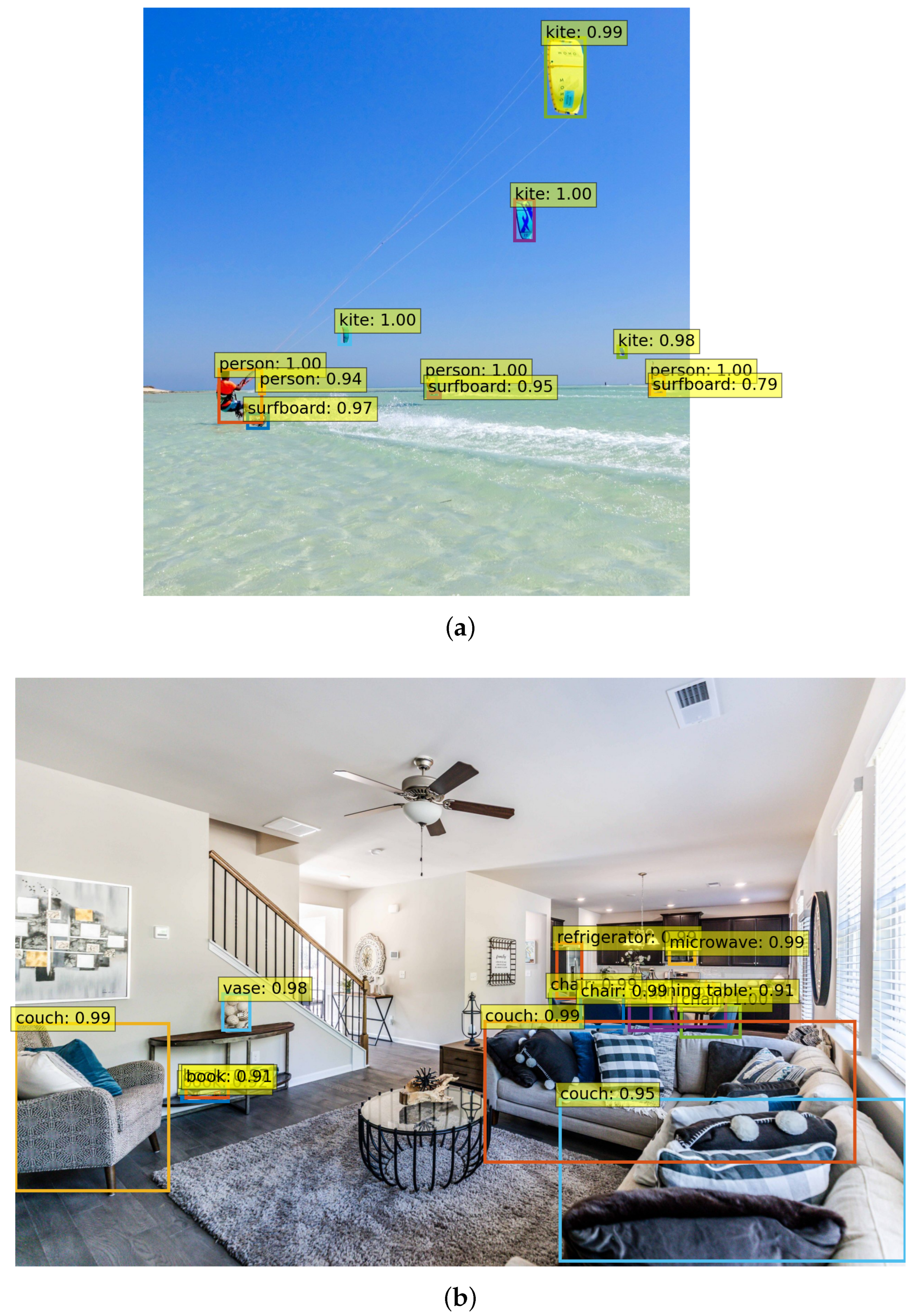
Appendix A.2. Smoke Density Detection vs. Ground Truth
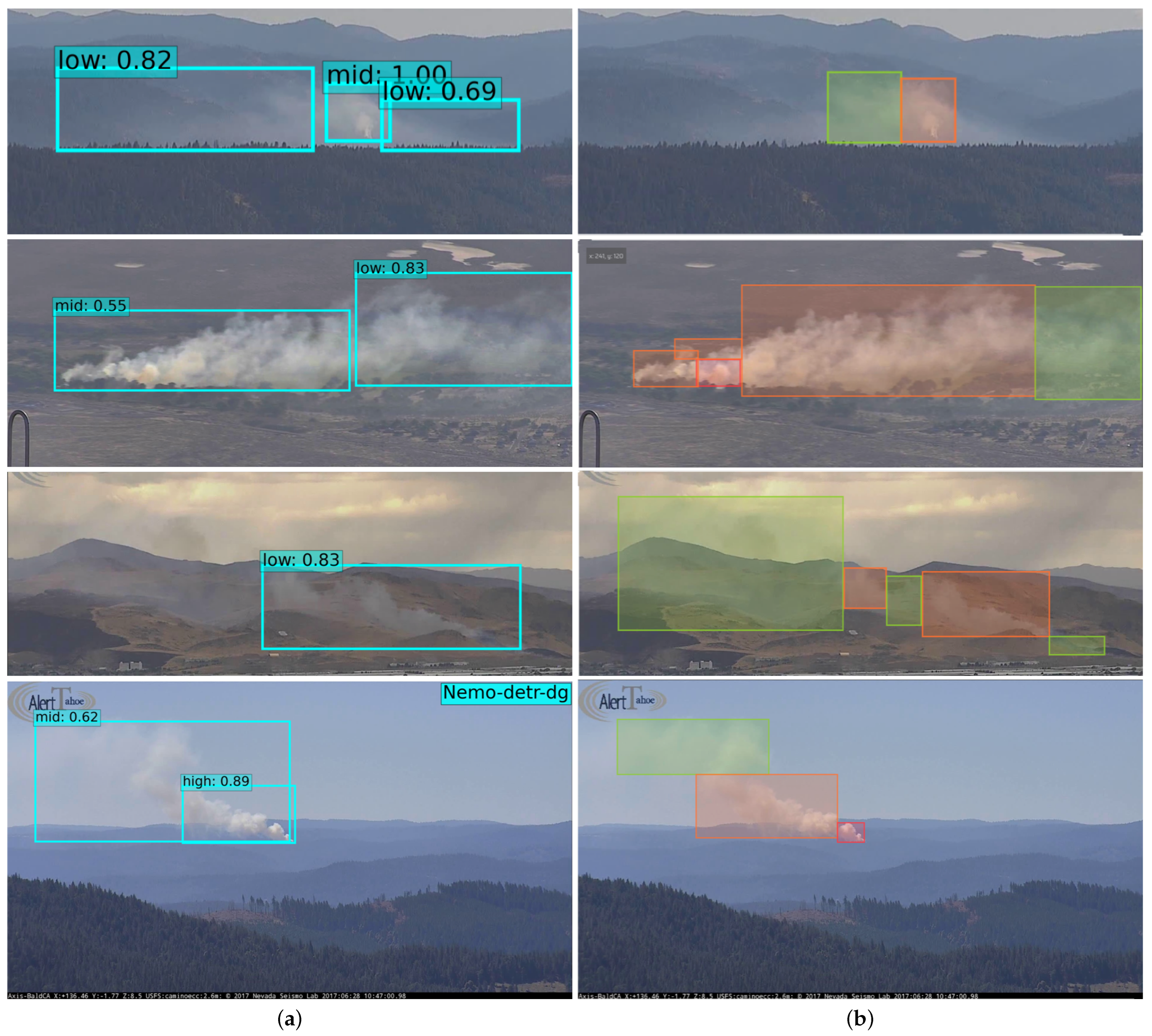
Appendix A.3. Full Time-Series Detection Results
| # | Video Name | Time Elapsed (min) | ||
|---|---|---|---|---|
| Nemo | ||||
| FRCNN-sc | RNet-sc | DETR-sc | ||
| 1 | 69bravo-e-mobo-c__2019-08-13 | 5 | 5 | 1 |
| 2 | 69bravo-n-mobo-c__2019-08-13 | 3 | 3 | 0 |
| 3 | bh-w-mobo-c__2019-06-10 | 9 | 10 | 4 |
| 4 | bh-w-mobo-c__2019-10-01 | N.D. | N.D. | 5 |
| 5 | bh-w-mobo-c__2019-10-03 | N.D. | N.D. | 3 |
| 6 | bl-n-mobo-c__2019-08-29 | 4 | 4 | 3 |
| 7 | bl-s-mobo-c__2019-07-16 | 8 | 8 | 3 |
| 8 | bl-s-mobo-c__2019-09-24 | 7 | 6 | 5 |
| 9 | bm-e-mobo-c__2019-10-05 | N.D. | 7 | 1 |
| 10 | hp-n-mobo-c__2019-06-29 | N.D. | 16 | 2 |
| 11 | hp-n-mobo-c__2019-07-16 | 12 | 11 | 6 |
| 12 | hp-s-mobo-c__2019-09-24 | N.D. | N.D. | 10 |
| 13 | hp-s-mobo-c__2019-10-05 | N.D. | N.D. | 4 |
| 14 | lo-s-mobo-c__2019-10-06 | 13 | 13 | 3 |
| 15 | lo-w-mobo-c__2019-09-24 | 9 | 11 | 3 |
| 16 | lo-w-mobo-c__2019-10-06 | 2 | 1 | 1 |
| 17 | lp-e-mobo-c__2019-10-06 | N.D. | N.D. | 1 |
| 18 | lp-e-mobo-c__2019-10-06 | N.D. | 21 | 29 |
| 19 | lp-n-mobo-c__2019-07-17 | 2 | 2 | 1 |
| 20 | lp-n-mobo-c__2019-07-28 | N.D. | 11 | 6 |
| 21 | lp-n-mobo-c__2019-09-24 | 4 | 5 | 1 |
| 22 | lp-n-mobo-c__2019-10-06 | 4 | 4 | 1 |
| 23 | lp-s-mobo-c__2019-08-14 | 7 | 6 | 5 |
| 24 | lp-s-mobo-c__2019-10-01 | 6 | N.D. | 2 |
| 25 | lp-s-mobo-c__2019-10-06 | 4 | 20 | 1 |
| 26 | lp-s-mobo-c__2019-10-07 | N.D. | N.D. | 3 |
| 27 | mg-n-mobo-c__2019-07-16 | 3 | 2 | 2 |
| 28 | ml-w-mobo-c__2019-09-22 | 3 | N.D. | 1 |
| 29 | ml-w-mobo-c__2019-09-24 | 4 | 4 | 3 |
| 30 | ml-w-mobo-c__2019-10-06 | 7 | 7 | 4 |
| 31 | om-e-mobo-c__2019-07-12 | 2 | 7 | 5 |
| 32 | om-e-mobo-c__2019-08-14 | 30 | 27 | 5 |
| 33 | om-e-mobo-c__2019-10-01 | 5 | 5 | 1 |
| 34 | om-n-mobo-c__2019-07-28 | N.D. | N.D. | 3 |
| 35 | om-n-mobo-c__2019-10-06 | 13 | N.D. | 2 |
| 36 | om-s-mobo-c__2019-09-30 | 3 | 2 | 1 |
| 37 | om-s-mobo-c__2019-10-01 | 10 | N.D. | 1 |
| 38 | om-s-mobo-c__2019-10-01 | 1 | 4 | 1 |
| 39 | om-s-mobo-c__2019-10-01 | 2 | N.D. | 2 |
| 40 | om-s-mobo-c__2019-10-03 | N.D. | N.D. | 2 |
| 41 | om-s-mobo-c__2019-10-06 | 18 | N.D. | 1 |
| 42 | om-s-mobo-c__2019-10-07 | N.D. | N.D. | 2 |
| 43 | om-w-mobo-c__2019-08-01 | N.D. | N.D. | N.D. |
| 44 | pi-e-mobo-c__2019-08-29 | N.D. | N.D. | N.D. |
| 45 | pi-s-mobo-c__2019-08-14 | 5 | 4 | 3 |
| 46 | pi-s-mobo-c__2019-08-26 | 31 | N.D. | 1 |
| 47 | pi-s-mobo-c__2019-10-06 | 4 | 15 | 1 |
| 48 | pi-w-mobo-c__2019-07-17 | N.D. | N.D. | 7 |
| 49 | pi-w-mobo-c__2019-09-24 | 6 | 8 | 2 |
| 50 | rm-w-mobo-c__2019-06-20 | 3 | 14 | 7 |
| 51 | rm-w-mobo-c__2019-08-26 | N.D. | N.D. | 3 |
| 52 | rm-w-mobo-c__2019-08-29 | N.D. | N.D. | 8 |
| 53 | rm-w-mobo-c__2019-10-01 | N.D. | 32 | 2 |
| 54 | rm-w-mobo-c__2019-10-03 | 2 | 3 | 1 |
| 55 | rm-w-mobo-c__2019-10-03 | 2 | 4 | 2 |
| 56 | rm-w-mobo-c__2019-10-03 | 2 | 3 | 1 |
| 57 | sdsc-e-mobo-c__2019-07-16 | N.D. | N.D. | 14 |
| 58 | sm-n-mobo-c__2019-09-24 | 8 | N.D. | 1 |
| 59 | sm-s-mobo-c__2019-10-07 | 7 | 7 | 1 |
| 60 | sm-w-mobo-c__2019-08-25 | 7 | 20 | 2 |
| 61 | smer-tcs8-mobo-c__2019-08-25 | N.D. | N.D. | 17 |
| 62 | smer-tcs8-mobo-c__2019-08-29 | 3 | 3 | 2 |
| 63 | smer-tcs9-mobo-c__2019-06-20 | 18 | N.D. | 3 |
| 64 | smer-tcs9-mobo-c__2019-10-01 | N.D. | N.D. | 4 |
| 65 | smer-tcs9-mobo-c__2019-10-01 | N.D. | 12 | 4 |
| 66 | smer-tcs9-mobo-c__2019-10-03 | N.D. | N.D. | 2 |
| 67 | smer-tcs9-mobo-c__2019-10-03 | 3 | N.D. | 1 |
| 68 | smer-tcs9-mobo-c__2019-10-03 | 4 | 3 | 1 |
| 69 | so-w-mobo-c__2019-07-16 | 0 | 2 | 0 |
| 70 | so-w-mobo-c__2019-08-27 | N.D. | N.D. | 1 |
| 71 | sp-e-mobo-c__2019-08-05 | N.D. | N.D. | 6 |
| 72 | sp-n-mobo-c__2019-07-28 | N.D. | N.D. | 8 |
| 73 | vo-n-mobo-c__2019-10-05 | 1 | 2 | 1 |
| 74 | wc-e-mobo-c__2019-09-24 | 12 | 12 | 2 |
| 75 | wc-e-mobo-c__2019-09-25 | 7 | 7 | 5 |
| 76 | wc-e-mobo-c__2019-10-05 | N.D. | N.D. | 1 |
| 77 | wc-n-mobo-c__2019-10-05 | N.D. | N.D. | 13 |
| 78 | wc-s-mobo-c__2019-09-24 | 10 | 11 | 8 |
| 79 | wc-s-mobo-c__2019-09-25 | N.D. | N.D. | 7 |
| R1: Detection rate (%) | 68.4 | 54.7 | 97.9 | |
| R2: Mean ± sd | 7.8 ± 6.9 | 10.17 ± 8.9 | 3.6 ± 4.1 | |
| R3: Mean ± sd w/imputation | 9.1 ± 7.5 | 11.4 ± 8.5 | 3.6 ± 4.1 | |
| R4: Median | 6 | 7 | 2 | |
| R5: Mean ± sd (79) | 6.8 ± 6.4 | 8.5 ± 6.9 | 3.66 ± 4.3 | |
References
- NIFC. Wildfires and Acres. Available online: https://www.nifc.gov/fire-information/statistics/wildfires (accessed on 1 February 2022).
- NOAA.gov. Wildfires–Annual 2021. Available online: https://www.ncdc.noaa.gov/sotc/fire/202113 (accessed on 1 February 2022).
- NIFC.gov. Suppression Costs. 2021. Available online: https://www.nifc.gov/fire-information/statistics/suppression-costs (accessed on 1 February 2022).
- Reid, C.E.; Brauer, M.; Johnston, F.H.; Jerrett, M.; Balmes, J.R.; Elliott, C.T. Critical Review of Health Impacts of Wildfire Smoke Exposure. Environ. Health Perspect. 2016, 124, 1334–1343. [Google Scholar] [CrossRef] [PubMed]
- Gaur, A.; Singh, A.; Kumar, A.; Kulkarni, K.S.; Lala, S.; Kapoor, K.; Srivastava, V.; Kumar, A.; Mukhopadhyay, S.C. Fire Sensing Technologies: A Review. IEEE Sens. J. 2019, 19, 3191–3202. [Google Scholar] [CrossRef]
- Barmpoutis, P.; Papaioannou, P.; Dimitropoulos, K.; Grammalidis, N. A Review on Early Forest Fire Detection Systems Using Optical Remote Sensing. Sensors 2020, 20, 6442. [Google Scholar] [CrossRef] [PubMed]
- Ba, R.; Chen, C.; Yuan, J.; Song, W.; Lo, S. SmokeNet: Satellite Smoke Scene Detection Using Convolutional Neural Network with Spatial and Channel-Wise Attention. Remote Sens. 2019, 11, 1702. [Google Scholar] [CrossRef]
- Yang, S.; Lupascu, M.; Meel, K.S. Predicting Forest Fire Using Remote Sensing Data And Machine Learning. Proc. Aaai Conf. Artif. Intell. 2021, 35, 14983–14990. [Google Scholar]
- Gholami, S.; Kodandapani, N.; Wang, J.; Lavista Ferres, J. Where there’s Smoke, there’s Fire: Wildfire Risk Predictive Modeling via Historical Climate Data. Proc. Aaai Conf. Artif. Intell. 2021, 35, 15309–15315. [Google Scholar]
- Xu, R.; Lin, H.; Lu, K.; Cao, L.; Liu, Y. A Forest Fire Detection System Based on Ensemble Learning. Forests 2021, 12, 217. [Google Scholar] [CrossRef]
- Govil, K.; Welch, M.L.; Ball, J.T.; Pennypacker, C.R. Preliminary Results from a Wildfire Detection System Using Deep Learning on Remote Camera Images. Remote Sens. 2020, 12, 166. [Google Scholar] [CrossRef]
- ALERTWildfire. ALERT Wildfire. 2022. Available online: https://www.alertwildfire.org/ (accessed on 1 February 2022).
- HPWREN. High Performance Wireless Research and Education Network. 2022. Available online: https://hpwren.ucsd.edu/ (accessed on 1 February 2022).
- The-Orange-County-Register. New Mountaintop Cameras Unveiled to Help Spot, Fight Far-Away Fires. 2018. Available online: https://www.ocregister.com/2018/05/23/new-mountaintop-cameras-unveiled-to-help-spot-fight-far-away-fires/ (accessed on 8 June 2022).
- National-Geographic. Wildfires. 2022. Available online: https://education.nationalgeographic.org/resource/wildfires (accessed on 1 February 2022).
- Guede-Fernández, F.; Martins, L.; de Almeida, R.V.; Gamboa, H.; Vieira, P. A Deep Learning Based Object Identification System for Forest Fire Detection. Fire 2021, 4, 75. [Google Scholar] [CrossRef]
- University of California San Diego. The HPWREN Fire Ignition Images Library for Neural Network Training. 2022. Available online: http://hpwren.ucsd.edu/HPWREN-FIgLib/ (accessed on 1 February 2022).
- Borges, P.V.K.; Izquierdo, E. A Probabilistic Approach for Vision-Based Fire Detection in Videos. IEEE Trans. Circuits Syst. Video Technol. 2010, 20, 721–731. [Google Scholar] [CrossRef]
- Zhang, Z.; Shen, T.; Zou, J. An Improved Probabilistic Approach for Fire Detection in Videos. Fire Technol. 2014, 50, 745–752. [Google Scholar] [CrossRef]
- Toreyin, B.U.; DedeogElu, Y.; Gudukbay, U.; Aetin, A.E. Computer vision based method for real-time fire and flame detection. Pattern Recognit. Lett. 2006, 27, 49–58. [Google Scholar] [CrossRef]
- Zhang, Q.; Xu, J.; Xu, L.; Guo, H. Deep Convolutional Neural Networks for Forest Fire Detection. In Proceedings of the 2016 International Forum on Management, Education and Information Technology Application, Guangzhou, China, 30–31 January 2016; pp. 568–575. [Google Scholar] [CrossRef]
- Wu, S.; Zhang, L. Using Popular Object Detection Methods for Real Time Forest Fire Detection. In Proceedings of the 2018 11th International Symposium on Computational Intelligence and Design (ISCID), Hangzhou, China, 8–9 December 2018; Volume 1, pp. 280–284. [Google Scholar] [CrossRef]
- Kim, B.; Lee, J. A Video-Based Fire Detection Using Deep Learning Models. Appl. Sci. 2019, 9, 2862. [Google Scholar] [CrossRef]
- Muhammad, K.; Ahmad, J.; Mehmood, I.; Rho, S.; Baik, S.W. Convolutional Neural Networks Based Fire Detection in Surveillance Videos. IEEE Access 2018, 6, 18174–18183. [Google Scholar] [CrossRef]
- Muhammad, K.; Ahmad, J.; Baik, S.W. Early fire detection using convolutional neural networks during surveillance for effective disaster management. Neurocomputing 2018, 288, 30–42. [Google Scholar] [CrossRef]
- Muhammad, K.; Ahmad, J.; Lv, Z.; Bellavista, P.; Yang, P.; Baik, S.W. Efficient Deep CNN-Based Fire Detection and Localization in Video Surveillance Applications. IEEE Trans. Syst. Man Cybern. Syst. 2019, 49, 1419–1434. [Google Scholar] [CrossRef]
- Muhammad, K.; Khan, S.; Elhoseny, M.; Hassan Ahmed, S.; Wook Baik, S. Efficient Fire Detection for Uncertain Surveillance Environment. IEEE Trans. Ind. Inform. 2019, 15, 3113–3122. [Google Scholar] [CrossRef]
- Jeon, M.; Choi, H.S.; Lee, J.; Kang, M. Multi-Scale Prediction For Fire Detection Using Convolutional Neural Network. Fire Technol. 2021, 57, 2533–2551. [Google Scholar] [CrossRef]
- Chaoxia, C.; Shang, W.; Zhang, F. Information-Guided Flame Detection Based on Faster R-CNN. IEEE Access 2020, 8, 58923–58932. [Google Scholar] [CrossRef]
- Park, M.; Tran, D.Q.; Jung, D.; Park, S. Wildfire-Detection Method Using DenseNet and CycleGAN Data Augmentation-Based Remote Camera Imagery. Remote Sens. 2020, 12, 3715. [Google Scholar] [CrossRef]
- Li, P.; Zhao, W. Image fire detection algorithms based on convolutional neural networks. Case Stud. Therm. Eng. 2020, 19, 100625. [Google Scholar] [CrossRef]
- Ajith, M.; Martínez-Ramón, M. Unsupervised Segmentation of Fire and Smoke From Infra-Red Videos. IEEE Access 2019, 7, 182381–182394. [Google Scholar] [CrossRef]
- NAMOZOV, A.; CHO, Y.I. An Efficient Deep Learning Algorithm for Fire and Smoke Detection with Limited Data. Adv. Electr. Comput. Eng. 2018, 18, 121–128. [Google Scholar] [CrossRef]
- Saponara, S.; Elhanashi, A.; Gagliardi, A. Real-time video fire/smoke detection based on CNN in antifire surveillance systems. J. Real Time Image Process. 2021, 18, 889–900. [Google Scholar] [CrossRef]
- Donida Labati, R.; Genovese, A.; Piuri, V.; Scotti, F. Wildfire Smoke Detection Using Computational Intelligence Techniques Enhanced With Synthetic Smoke Plume Generation. IEEE Trans. Syst. Man, Cybern. Syst. 2013, 43, 1003–1012. [Google Scholar] [CrossRef]
- IQ FireWatch Technology. Available online: https://www.iq-firewatch.com/technology (accessed on 10 February 2022).
- ForestWatch. Available online: http://evsusa.biz/productsservices/forestwatch/ (accessed on 10 February 2022).
- Pan, H.; Badawi, D.; Cetin, A.E. Computationally Efficient Wildfire Detection Method Using a Deep Convolutional Network Pruned via Fourier Analysis. Sensors 2020, 20, 2891. [Google Scholar] [CrossRef]
- Lin, T.Y.; Dollar, P.; Girshick, R.; He, K.; Hariharan, B.; Belongie, S. Feature Pyramid Networks for Object Detection. In Proceedings of the IEEE Conference on Computer Vision and Pattern Recognition (CVPR), Honolulu, HI, USA, 21–26 July 2017. [Google Scholar]
- Tan, M.; Pang, R.; Le, Q.V. EfficientDet: Scalable and Efficient Object Detection. In Proceedings of the IEEE/CVF Conference on Computer Vision and Pattern Recognition (CVPR), Seattle, WA, USA, 13–19 June 2020. [Google Scholar]
- Lin, T.Y.; Goyal, P.; Girshick, R.; He, K.; Dollar, P. Focal Loss for Dense Object Detection. In Proceedings of the IEEE International Conference on Computer Vision (ICCV), Venice, Italy, 22–29 October 2017. [Google Scholar]
- Redmon, J.; Farhadi, A. Yolov3: An incremental improvement. arXiv 2018, arXiv:1804.02767. [Google Scholar]
- Jocher, G. ultralytics/yolov5: V3.1—Bug Fixes and Performance Improvements. 2020. Available online: https://github.com/ultralytics/yolov5 (accessed on 1 February 2022).
- Devlin, J.; Chang, M.W.; Lee, K.; Toutanova, K. BERT: Pre-training of Deep Bidirectional Transformers for Language Understanding. arXiv 2018, arXiv:1810.04805. [Google Scholar] [CrossRef]
- Yang, Z.; Xu, C.; Li, L. Landslide Detection Based on ResU-Net with Transformer and CBAM Embedded: Two Examples with Geologically Different Environments. Remote Sens. 2022, 14, 2885. [Google Scholar] [CrossRef]
- Ghali, R.; Akhloufi, M.A.; Jmal, M.; Souidene Mseddi, W.; Attia, R. Wildfire Segmentation Using Deep Vision Transformers. Remote Sens. 2021, 13, 3527. [Google Scholar] [CrossRef]
- Carion, N.; Massa, F.; Synnaeve, G.; Usunier, N.; Kirillov, A.; Zagoruyko, S. End-to-End Object Detection with Transformers. In Proceedings of the Computer Vision—ECCV 2020; Vedaldi, A., Bischof, H., Brox, T., Frahm, J.M., Eds.; Springer International Publishing: Cham, Switzerland, 2020; pp. 213–229. [Google Scholar]
- Yazdi, A. Nemo: Nevada Smoke Detection Benchmark. 2022. Available online: https://github.com/SayBender/Nemo (accessed on 1 August 2022).
- Jiao, Z.; Zhang, Y.; Mu, L.; Xin, J.; Jiao, S.; Liu, H.; Liu, D. A YOLOv3-based Learning Strategy for Real-time UAV-based Forest Fire Detection. In Proceedings of the 2020 Chinese Control And Decision Conference (CCDC), Hefei, China, 22–24 August 2020; pp. 4963–4967. [Google Scholar] [CrossRef]
- Jiao, Z.; Zhang, Y.; Xin, J.; Mu, L.; Yi, Y.; Liu, H.; Liu, D. A Deep Learning Based Forest Fire Detection Approach Using UAV and YOLOv3. In Proceedings of the 2019 1st International Conference on Industrial Artificial Intelligence (IAI), Shenyang, China, 22–26 July 2019; pp. 1–5. [Google Scholar] [CrossRef]
- Barmpoutis, P.; Dimitropoulos, K.; Kaza, K.; Grammalidis, N. Fire detection from images using faster R-CNN and multidimensional texture analysis. In Proceedings of the ICASSP 2019-2019 IEEE International Conference on Acoustics, Speech and Signal Processing (ICASSP), Brighton, UK, 12–17 May 2019; pp. 8301–8305. [Google Scholar]
- Yin, Z.; Wan, B.; Yuan, F.; Xia, X.; Shi, J. A Deep Normalization and Convolutional Neural Network for Image Smoke Detection. IEEE Access 2017, 5, 18429–18438. [Google Scholar] [CrossRef]
- Healey, G.; Slater, D.; Lin, T.; Drda, B.; Goedeke, A. A system for real-time fire detection. In Proceedings of the IEEE Conference on Computer Vision and Pattern Recognition, New York, NY, USA, 15–17 June 1993; pp. 605–606. [Google Scholar] [CrossRef]
- CHEN, T.H.; WU, P.H.; CHIOU, Y.C. An early fire-detection method based on image processing. In Proceedings of the 2004 International Conference on Image Processing (ICIP ’04), Singapore, 24–27 October 2004; IEEE: Piscataway, NJ, USA, 2004; Volume 3, pp. 1707–1710. [Google Scholar]
- Horng, W.B.; Peng, J.W.; Chen, C.Y. A new image-based real-time flame detection method using color analysis. In Proceedings of the 2005 IEEE Networking, Sensing and Control, Tucson, AZ, USA, 19–22 March 2005; pp. 100–105. [Google Scholar] [CrossRef]
- Chino, D.Y.T.; Avalhais, L.P.S.; Rodrigues, J.F.; Traina, A.J.M. BoWFire: Detection of Fire in Still Images by Integrating Pixel Color and Texture Analysis. In Proceedings of the 2015 28th SIBGRAPI Conference on Graphics, Patterns and Images, Salvador, Brazil, 26–29 August 2015; pp. 95–102. [Google Scholar] [CrossRef]
- Ko, B.C.; Cheong, K.H.; Nam, J.Y. Fire detection based on vision sensor and support vector machines. Fire Saf. J. 2009, 44, 322–329. [Google Scholar] [CrossRef]
- Foggia, P.; Saggese, A.; Vento, M. Real-Time Fire Detection for Video-Surveillance Applications Using a Combination of Experts Based on Color, Shape, and Motion. IEEE Trans. Circuits Syst. Video Technol. 2015, 25, 1545–1556. [Google Scholar] [CrossRef]
- Prema, C.E.; Vinsley, S.S.; Suresh, S. Efficient Flame Detection Based on Static and Dynamic Texture Analysis in Forest Fire Detection. Fire Technol. 2017, 54, 255–288. [Google Scholar] [CrossRef]
- Gholamnia, K.; Gudiyangada Nachappa, T.; Ghorbanzadeh, O.; Blaschke, T. Comparisons of Diverse Machine Learning Approaches for Wildfire Susceptibility Mapping. Symmetry 2020, 12, 604. [Google Scholar] [CrossRef]
- Abdollahi, A.; Pradhan, B.; Shukla, N.; Chakraborty, S.; Alamri, A. Deep Learning Approaches Applied to Remote Sensing Datasets for Road Extraction: A State-Of-The-Art Review. Remote Sens. 2020, 12, 1444. [Google Scholar] [CrossRef]
- Kamilaris, A.; Prenafeta-Boldú, F.X. Deep learning in agriculture: A survey. Comput. Electron. Agric. 2018, 147, 70–90. [Google Scholar] [CrossRef]
- Litjens, G.; Kooi, T.; Bejnordi, B.E.; Setio, A.A.A.; Ciompi, F.; Ghafoorian, M.; van der Laak, J.A.; van Ginneken, B.; Sánchez, C.I. A survey on deep learning in medical image analysis. Med. Image Anal. 2017, 42, 60–88. [Google Scholar] [CrossRef]
- Ghorbanzadeh, O.; Crivellari, A.; Ghamisi, P.; Shahabi, H.; Blaschke, T. A comprehensive transferability evaluation of U-Net and ResU-Net for landslide detection from Sentinel-2 data (case study areas from Taiwan, China, and Japan). Sci. Rep. 2021, 11, 14629. [Google Scholar] [CrossRef]
- Ghorbanzadeh, O.; Xu, Y.; Ghamisi, P.; Kopp, M.; Kreil, D. Landslide4Sense: Reference Benchmark Data and Deep Learning Models for Landslide Detection. arXiv 2022, arXiv:2206.00515. [Google Scholar] [CrossRef]
- Minaee, S.; Boykov, Y.Y.; Porikli, F.; Plaza, A.J.; Kehtarnavaz, N.; Terzopoulos, D. Image Segmentation Using Deep Learning: A Survey. IEEE Trans. Pattern Anal. Mach. Intell. 2021, 44, 3523–3542. [Google Scholar] [CrossRef] [PubMed]
- Zhao, Z.Q.; Zheng, P.; Xu, S.T.; Wu, X. Object Detection With Deep Learning: A Review. IEEE Trans. Neural Netw. Learn. Syst. 2019, 30, 3212–3232. [Google Scholar] [CrossRef] [PubMed]
- Redmon, J.; Divvala, S.; Girshick, R.; Farhadi, A. You Only Look Once: Unified, Real-Time Object Detection. In Proceedings of the IEEE Conference on Computer Vision and Pattern Recognition (CVPR), Las Vegas, NV, USA, 27–30 June 2016. [Google Scholar]
- Redmon, J.; Farhadi, A. YOLO9000: Better, Faster, Stronger. In Proceedings of the IEEE Conference on Computer Vision and Pattern Recognition (CVPR), Honolulu, HI, USA, 21–26 July 2017. [Google Scholar]
- Liu, W.; Anguelov, D.; Erhan, D.; Szegedy, C.; Reed, S.; Fu, C.Y.; Berg, A.C. Ssd: Single shot multibox detector. In Proceedings of the European Conference on Computer Vision, Amsterdam, The Netherlands, 11–14 October 2016; pp. 21–37. [Google Scholar]
- Zhu, X.; Su, W.; Lu, L.; Li, B.; Wang, X.; Dai, J. Deformable DETR: Deformable Transformers for End-to-End Object Detection. arXiv 2020, arXiv:2010.04159. [Google Scholar]
- Girshick, R.; Donahue, J.; Darrell, T.; Malik, J. Rich Feature Hierarchies for Accurate Object Detection and Semantic Segmentation. In Proceedings of the IEEE Conference on Computer Vision and Pattern Recognition (CVPR), Columbus, OH, USA, 23–28 June 2014. [Google Scholar]
- Ren, S.; He, K.; Girshick, R.; Sun, J. Faster R-CNN: Towards Real-Time Object Detection with Region Proposal Networks. In Proceedings of the Advances in Neural Information Processing Systems; Cortes, C., Lawrence, N., Lee, D., Sugiyama, M., Garnett, R., Eds.; Curran Associates, Inc.: Red Hook, NY, USA, 2015; Volume 28. [Google Scholar]
- He, K.; Gkioxari, G.; Dollar, P.; Girshick, R. Mask R-CNN. In Proceedings of the IEEE International Conference on Computer Vision (ICCV), Venice, Italy, 22–29 October 2017. [Google Scholar]
- Jiao, L.; Zhang, F.; Liu, F.; Yang, S.; Li, L.; Feng, Z.; Qu, R. A Survey of Deep Learning-Based Object Detection. IEEE Access 2019, 7, 128837–128868. [Google Scholar] [CrossRef]
- Uijlings, J.R.; Van De Sande, K.E.; Gevers, T.; Smeulders, A.W. Selective search for object recognition. Int. J. Comput. Vis. 2013, 104, 154–171. [Google Scholar] [CrossRef]
- Jain, P.; Coogan, S.C.; Subramanian, S.G.; Crowley, M.; Taylor, S.; Flannigan, M.D. A review of machine learning applications in wildfire science and management. Environ. Rev. 2020, 28, 478–505. [Google Scholar] [CrossRef]
- Szegedy, C.; Liu, W.; Jia, Y.; Sermanet, P.; Reed, S.; Anguelov, D.; Erhan, D.; Vanhoucke, V.; Rabinovich, A. Going Deeper With Convolutions. In Proceedings of the IEEE Conference on Computer Vision and Pattern Recognition (CVPR), Boston, MA, USA, 7–12 June 2015. [Google Scholar]
- Krizhevsky, A.; Sutskever, I.; Hinton, G.E. ImageNet Classification with Deep Convolutional Neural Networks. In Proceedings of the Advances in Neural Information Processing Systems; Pereira, F., Burges, C.J.C., Bottou, L., Weinberger, K.Q., Eds.; Curran Associates, Inc.: Red Hook, NY, USA, 2012; Volume 25. [Google Scholar]
- Sandler, M.; Howard, A.; Zhu, M.; Zhmoginov, A.; Chen, L.C. MobileNetV2: Inverted Residuals and Linear Bottlenecks. In Proceedings of the IEEE Conference on Computer Vision and Pattern Recognition (CVPR), Salt Lake City, UT, USA, 18–23 June 2018. [Google Scholar]
- Zhang, Q.X.; Lin, G.H.; Zhang, Y.M.; Xu, G.; Wang, J.J. Wildland Forest Fire Smoke Detection Based on Faster R-CNN using Synthetic Smoke Images. Procedia Eng. 2018, 211, 441–446. [Google Scholar] [CrossRef]
- Szegedy, C.; Vanhoucke, V.; Ioffe, S.; Shlens, J.; Wojna, Z. Rethinking the Inception Architecture for Computer Vision. In Proceedings of the IEEE Conference on Computer Vision and Pattern Recognition (CVPR), Las Vegas, NV, USA, 27–30 June 2016. [Google Scholar]
- Huang, G.; Liu, Z.; van der Maaten, L.; Weinberger, K.Q. Densely Connected Convolutional Networks. In Proceedings of the IEEE Conference on Computer Vision and Pattern Recognition (CVPR), Honolulu, HI, USA, 21–26 July 2017. [Google Scholar]
- Goodfellow, I.; Pouget-Abadie, J.; Mirza, M.; Xu, B.; Warde-Farley, D.; Ozair, S.; Courville, A.; Bengio, Y. Generative Adversarial Nets. In Proceedings of the Advances in Neural Information Processing Systems; Ghahramani, Z., Welling, M., Cortes, C., Lawrence, N., Weinberger, K.Q., Eds.; Curran Associates, Inc.: Red Hook, NY, USA, 2014; Volume 27. [Google Scholar]
- Zhu, J.Y.; Park, T.; Isola, P.; Efros, A.A. Unpaired Image-To-Image Translation Using Cycle-Consistent Adversarial Networks. In Proceedings of the IEEE International Conference on Computer Vision (ICCV), Venice, Italy, 22–29 October 2017. [Google Scholar]
- Dai, J.; Li, Y.; He, K.; Sun, J. R-FCN: Object Detection via Region-based Fully Convolutional Networks. In Proceedings of the Advances in Neural Information Processing Systems; Lee, D., Sugiyama, M., Luxburg, U., Guyon, I., Garnett, R., Eds.; Curran Associates, Inc.: Red Hook, NY, USA, 2016; Volume 29. [Google Scholar]
- Tan, M.; Le, Q. EfficientNet: Rethinking Model Scaling for Convolutional Neural Networks. In Proceedings of the 36th International Conference on Machine Learning, Long Beach, CA, USA, 9–15 June 2019; Volume 97, pp. 6105–6114. [Google Scholar]
- Dosovitskiy, A.; Beyer, L.; Kolesnikov, A.; Weissenborn, D.; Zhai, X.; Unterthiner, T.; Dehghani, M.; Minderer, M.; Heigold, G.; Gelly, S.; et al. An Image is Worth 16x16 Words: Transformers for Image Recognition at Scale. arXiv 2021, arXiv:2010.11929. [Google Scholar] [CrossRef]
- Khan, S.; Naseer, M.; Hayat, M.; Zamir, S.W.; Khan, F.S.; Shah, M. Transformers in Vision: A Survey. ACM Comput. Surv. 2021. [Google Scholar] [CrossRef]
- Dai, Z.; Cai, B.; Lin, Y.; Chen, J. UP-DETR: Unsupervised Pre-Training for Object Detection With Transformers. In Proceedings of the IEEE/CVF Conference on Computer Vision and Pattern Recognition (CVPR), Virtual, 19–25 June 2021; pp. 1601–1610. [Google Scholar]
- Dai, X.; Chen, Y.; Yang, J.; Zhang, P.; Yuan, L.; Zhang, L. Dynamic DETR: End-to-End Object Detection With Dynamic Attention. In Proceedings of the IEEE/CVF International Conference on Computer Vision (ICCV), Montreal, QC, Canada, 10–17 October 2021; pp. 2988–2997. [Google Scholar]
- Tavakkoli Piralilou, S.; Einali, G.; Ghorbanzadeh, O.; Nachappa, T.G.; Gholamnia, K.; Blaschke, T.; Ghamisi, P. A Google Earth Engine Approach for Wildfire Susceptibility Prediction Fusion with Remote Sensing Data of Different Spatial Resolutions. Remote Sens. 2022, 14, 672. [Google Scholar] [CrossRef]
- Abdi, O.; Kamkar, B.; Shirvani, Z.; da Silva, J.A.T.; Buchroithner, M.F. Spatial-statistical analysis of factors determining forest fires: A case study from Golestan, Northeast Iran. Geomat. Nat. Hazards Risk 2018, 9, 267–280. [Google Scholar] [CrossRef]
- NSL. Nevada Seismological Lab. 2022. Available online: http://www.seismo.unr.edu/ (accessed on 1 February 2022).
- Skalski, P. Make Sense. 2019. Available online: https://github.com/SkalskiP/make-sense/ (accessed on 1 February 2022).
- Vaswani, A.; Shazeer, N.; Parmar, N.; Uszkoreit, J.; Jones, L.; Gomez, A.N.; Kaiser, L.; Polosukhin, I. Attention is All You Need. In Proceedings of the 31st International Conference on Neural Information Processing Systems; Curran Associates Inc.: Red Hook, NY, USA, 2017; pp. 6000–6010. [Google Scholar]
- Rezatofighi, H.; Tsoi, N.; Gwak, J.; Sadeghian, A.; Reid, I.; Savarese, S. Generalized Intersection Over Union: A Metric and a Loss for Bounding Box Regression. In Proceedings of the IEEE/CVF Conference on Computer Vision and Pattern Recognition (CVPR), Long Beach, CA, USA, 16–20 June 2019. [Google Scholar]
- COCO-Common Objects in Context. 2022. Available online: https://cocodataset.org/#explore (accessed on 1 February 2022).
- An Unprecedented Colorado Wildfire is Burning Despite the Presence of Snow on the Ground. Available online: https://www.salon.com/2022/03/31/an-unprecedented-colorado-wildfire-is-burning-despite-the-presence-of-snow-on-the-ground/ (accessed on 16 June 2022).
- Massa, F. PyTorch Vision Releases. 2022. Available online: https://github.com/pytorch/vision/releases (accessed on 1 February 2022).
- COCO-API. 2022. Available online: https://github.com/cocodataset/cocoapi/blob/master/PythonAPI/pycocotools/cocoeval.py (accessed on 1 February 2022).
- Govil, K. Firecam Datasets. 2022. Available online: https://github.com/open-climate-tech/firecam/tree/master/datasets (accessed on 1 February 2022).
- NPS.GOV. The United States National Parks Services. Wildfire Causes and Evaluations. 2022. Available online: https://www.nps.gov/articles/wildfire-causes-and-evaluation.htm (accessed on 1 February 2022).
- Facebook. DETR Hands-On Collab. 2022. Available online: https://colab.research.google.com/github/facebookresearch/detr/blob/colab/notebooks/detr_attention.ipynb (accessed on 1 February 2022).
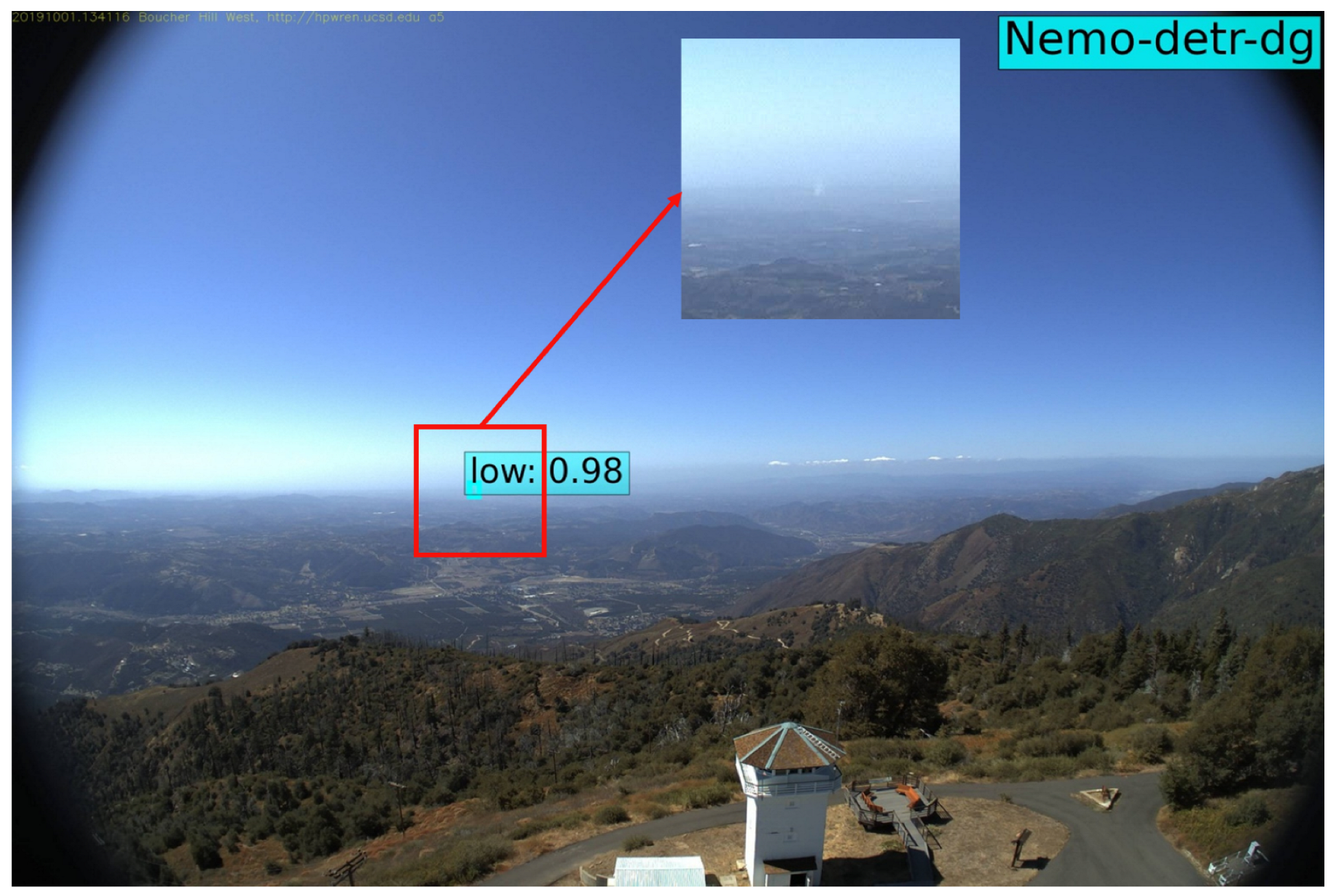
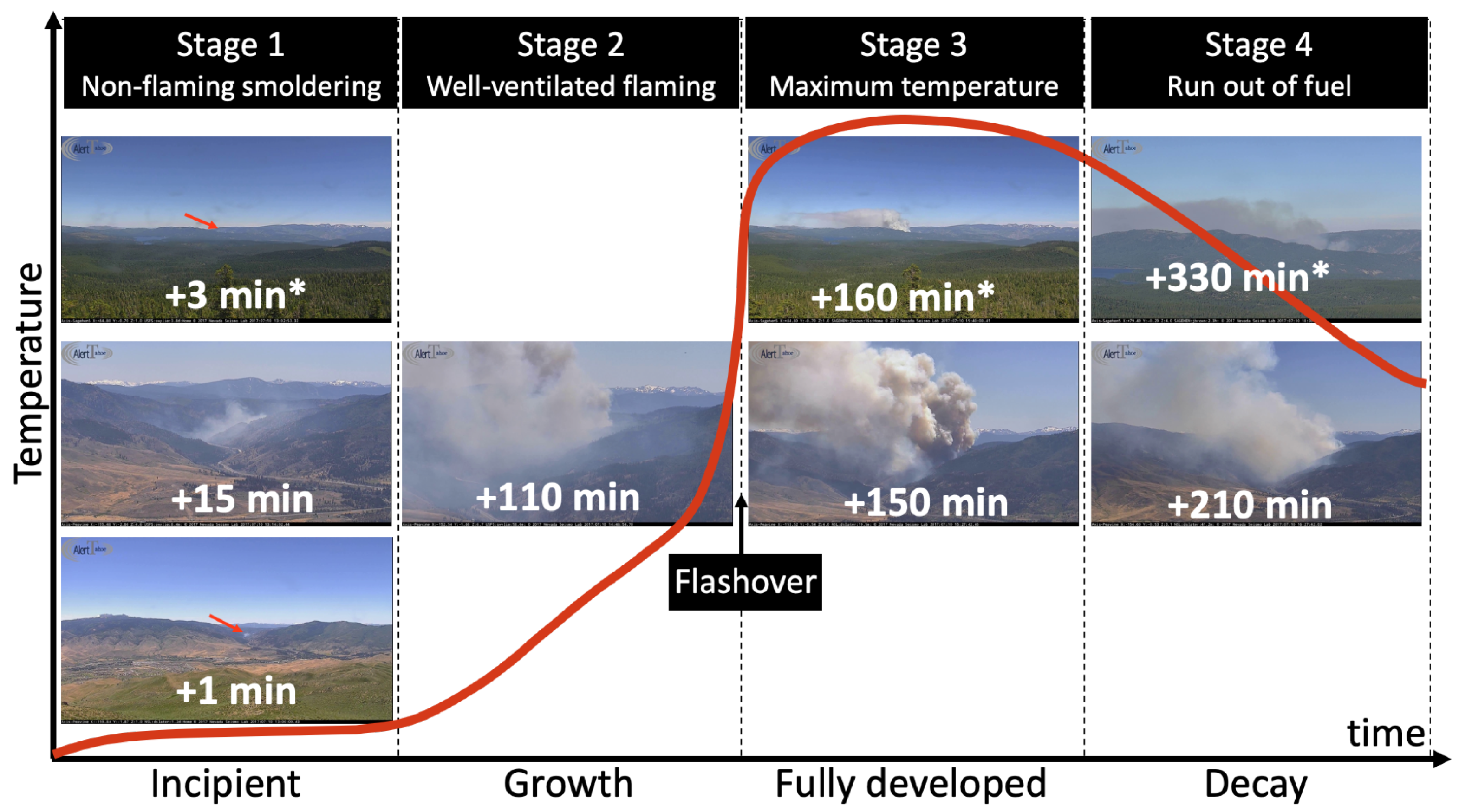
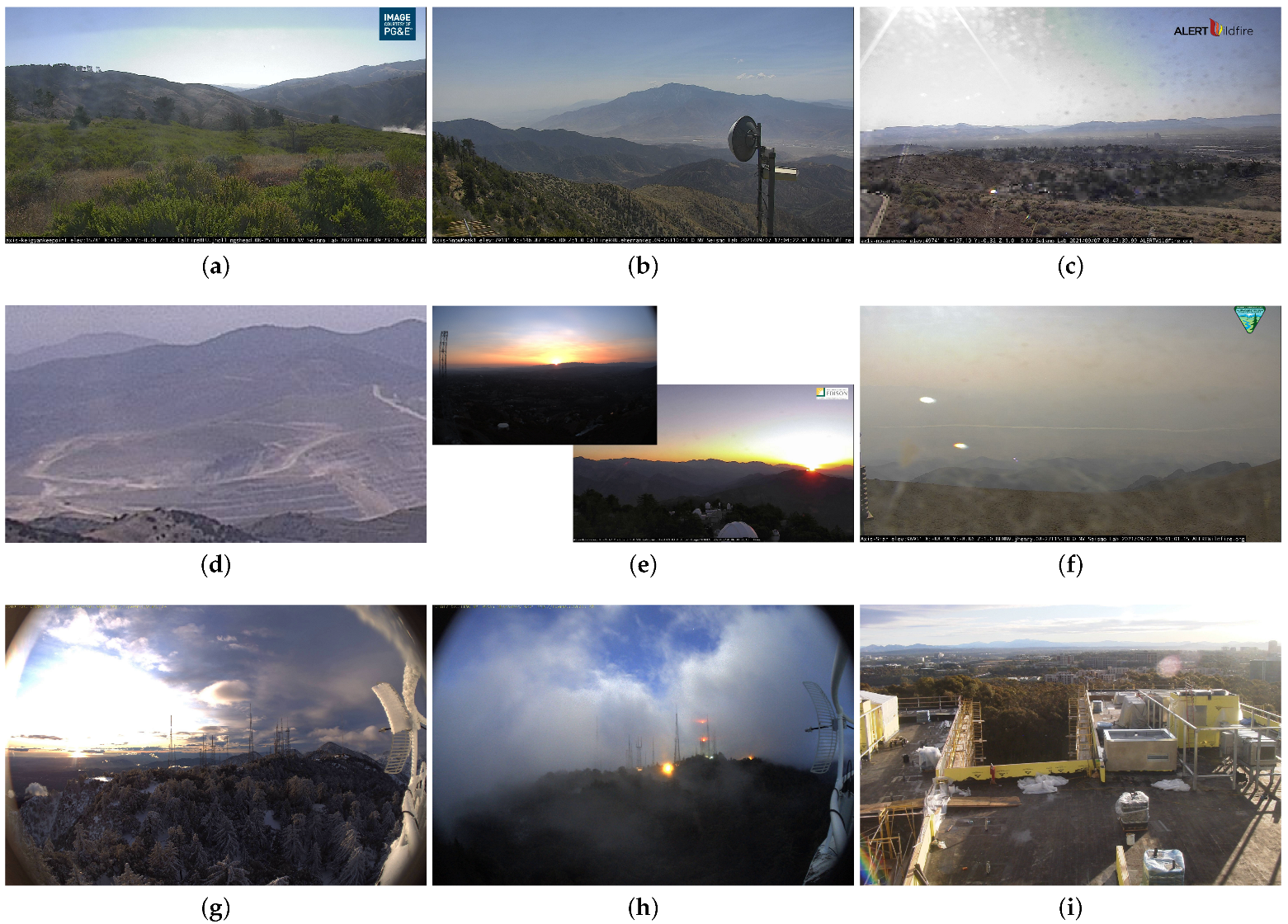

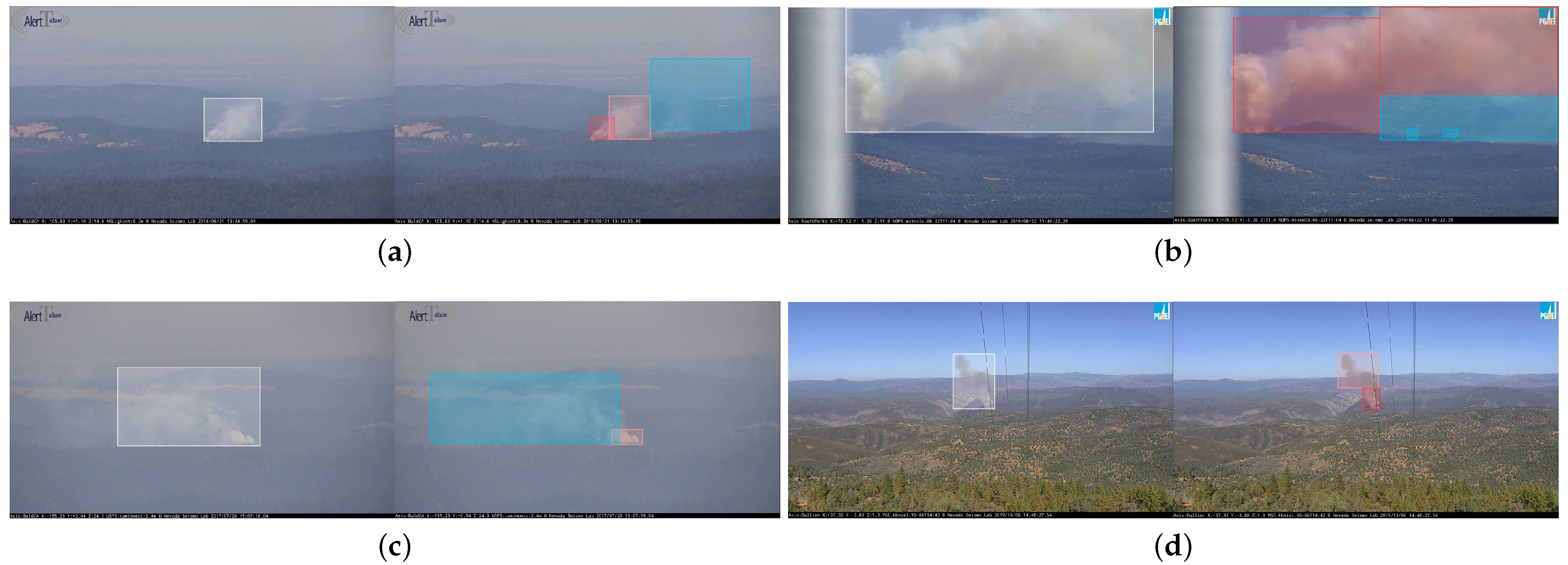
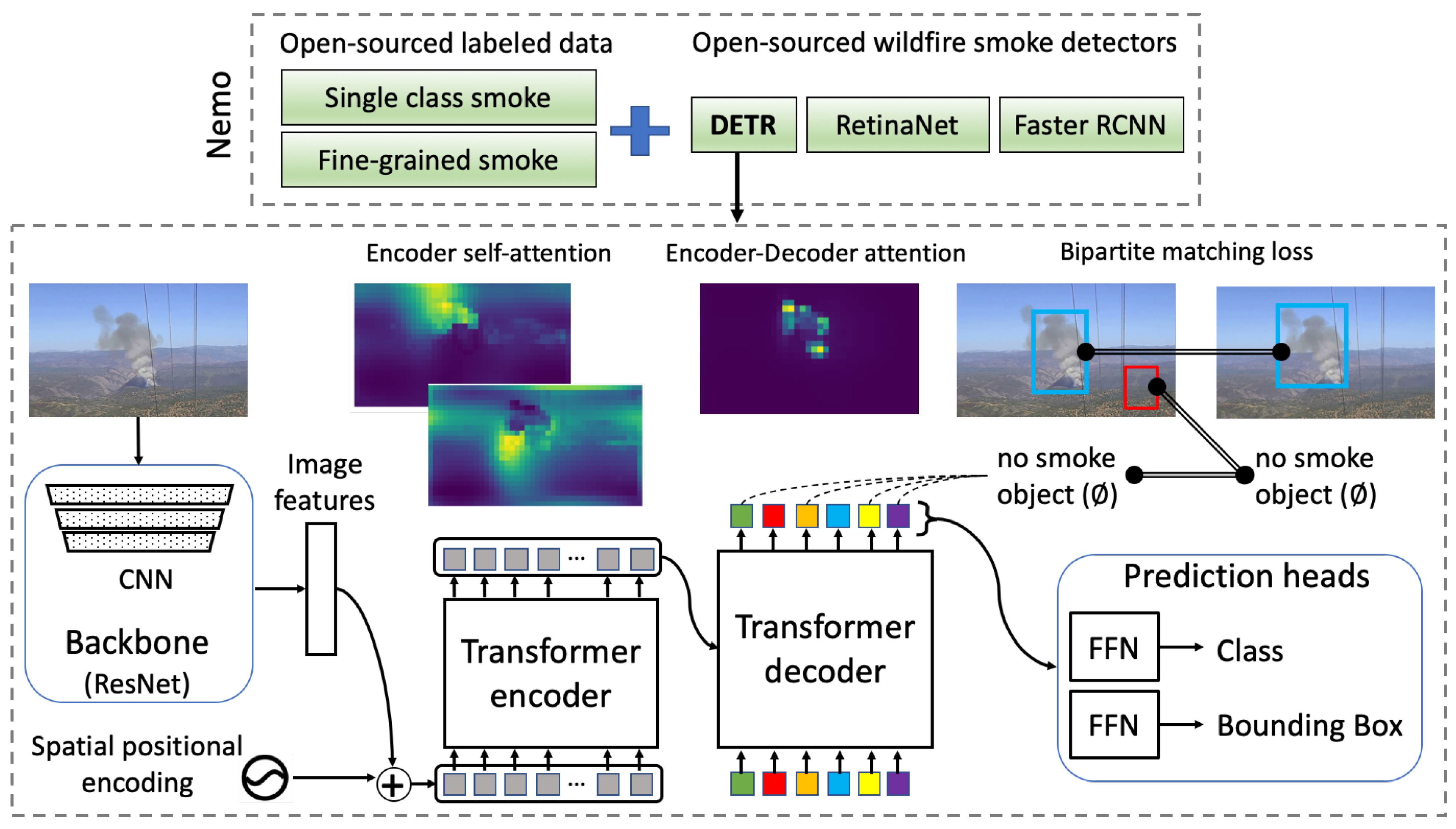
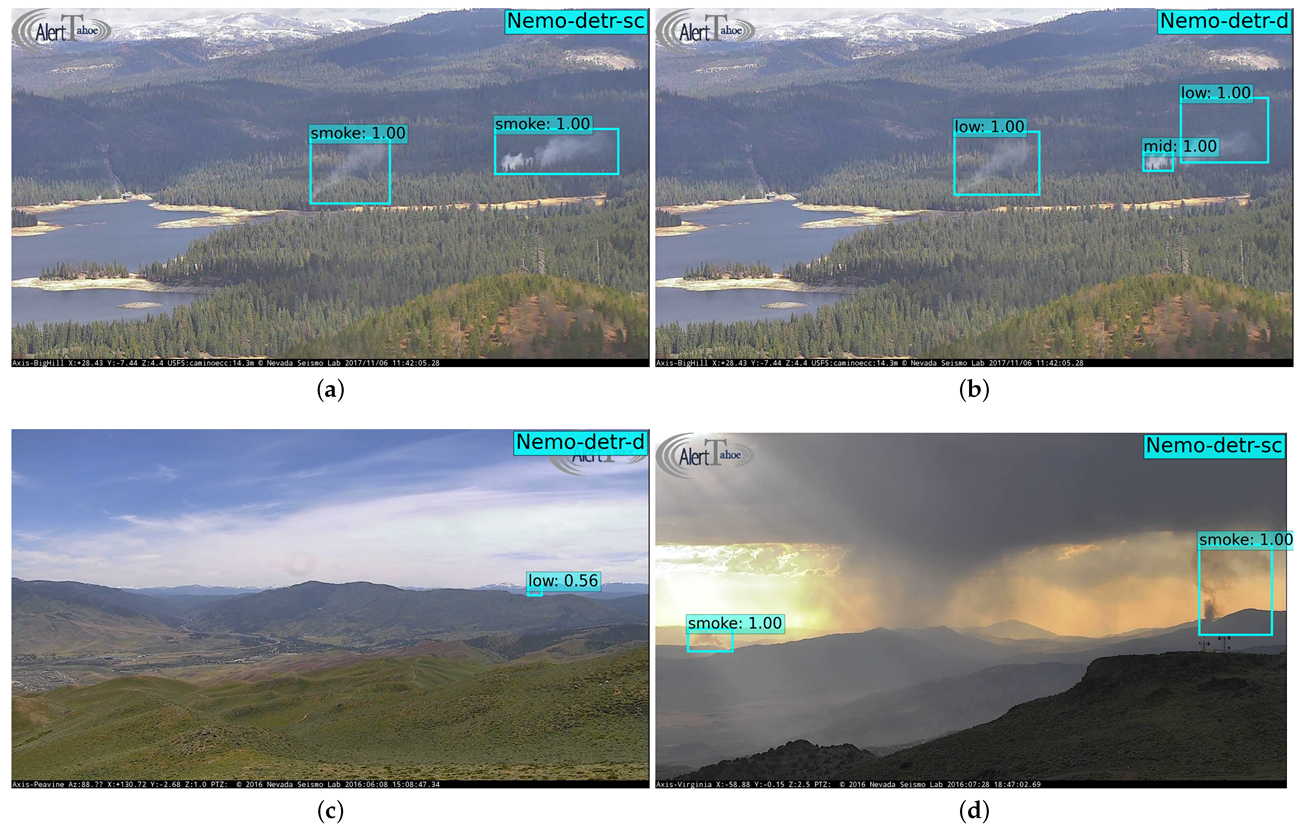
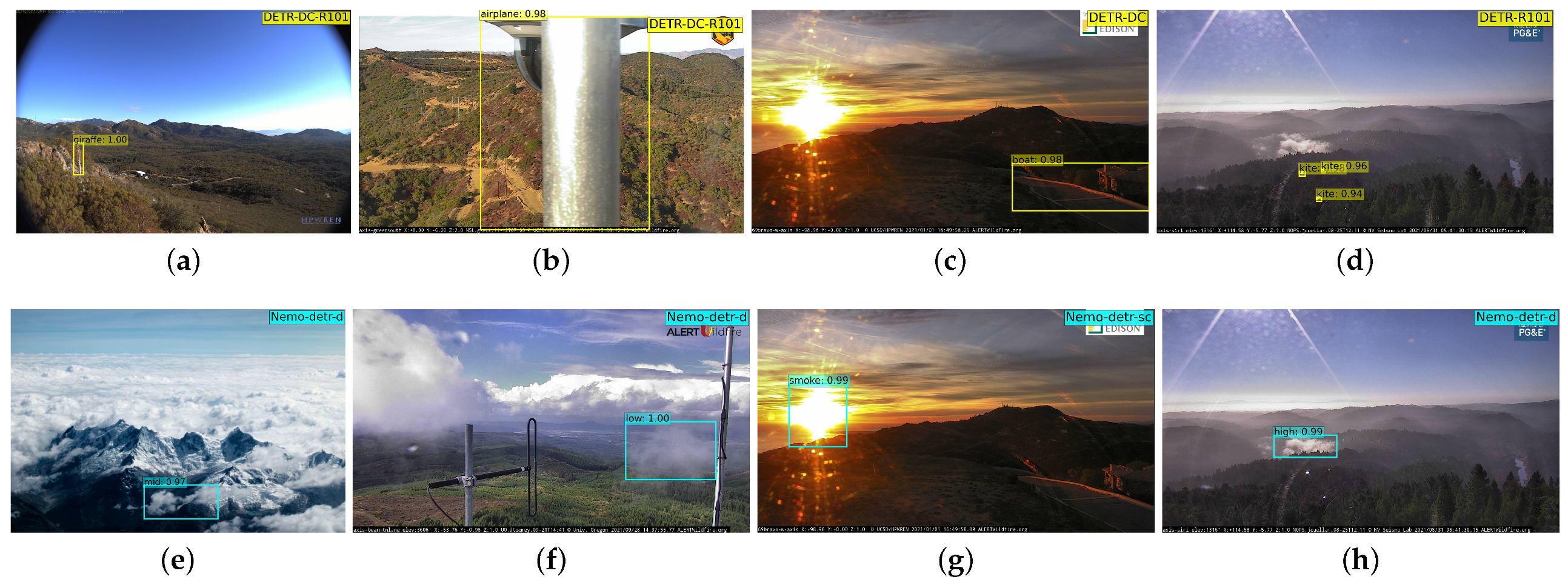

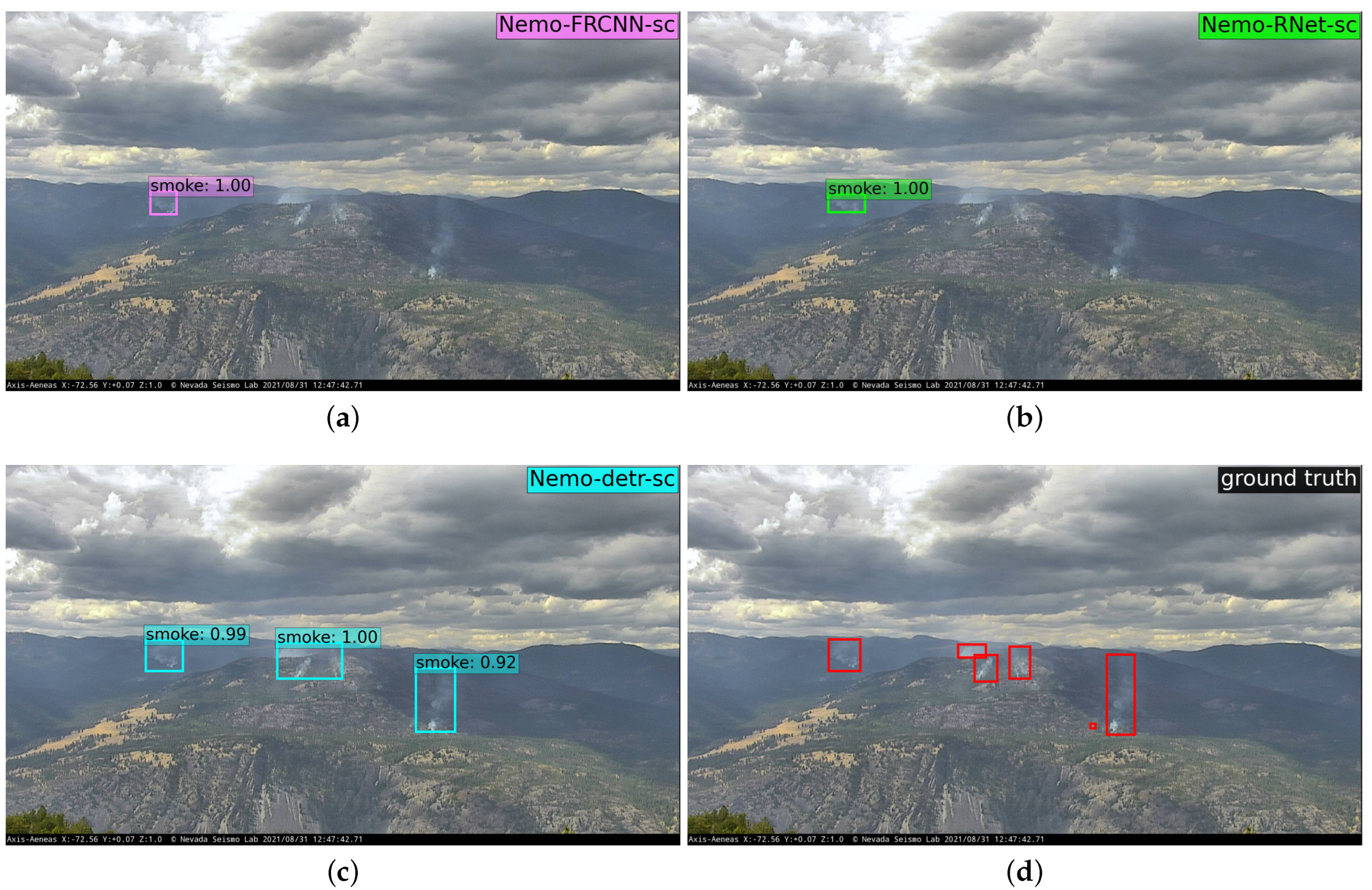
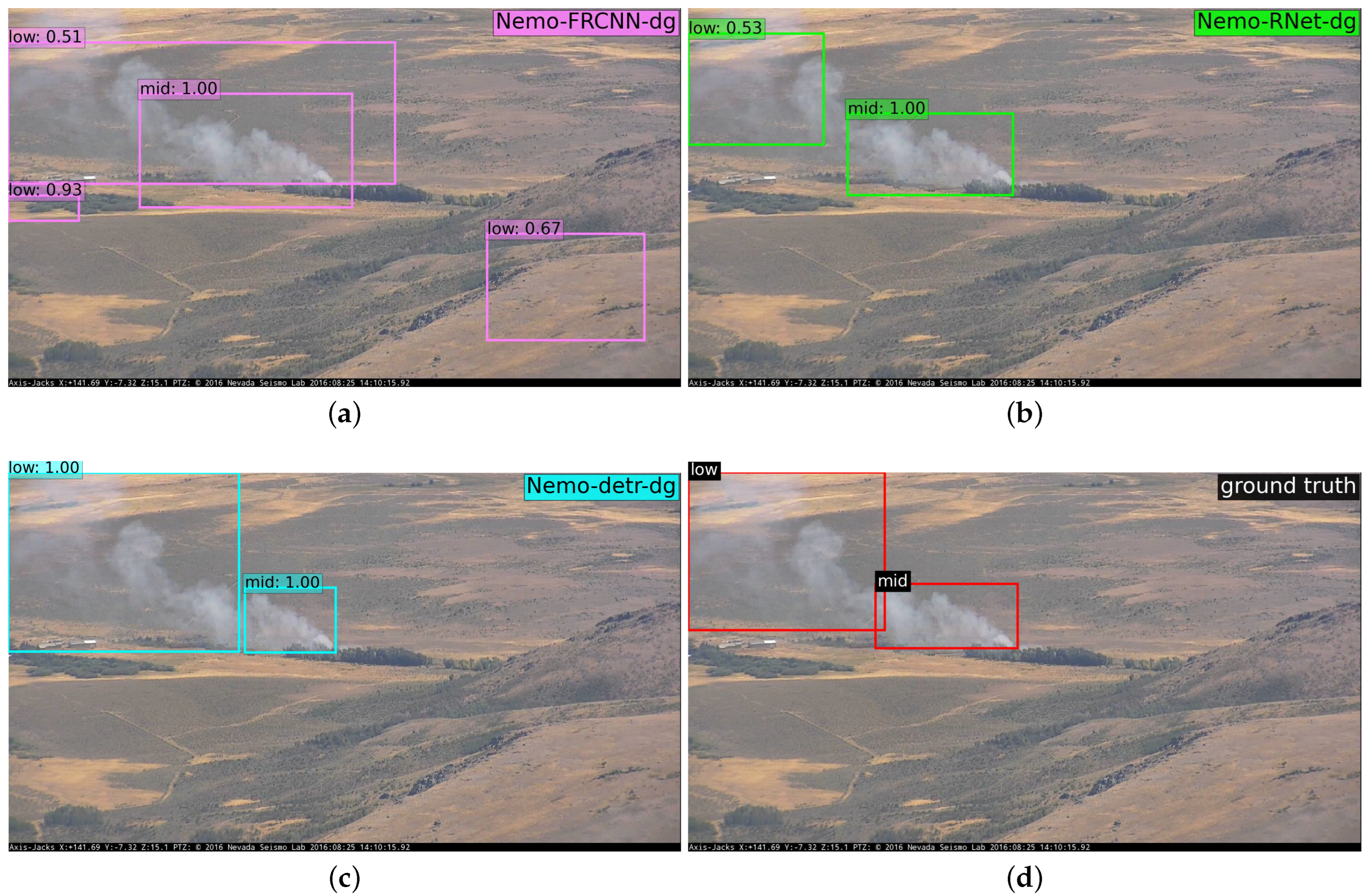
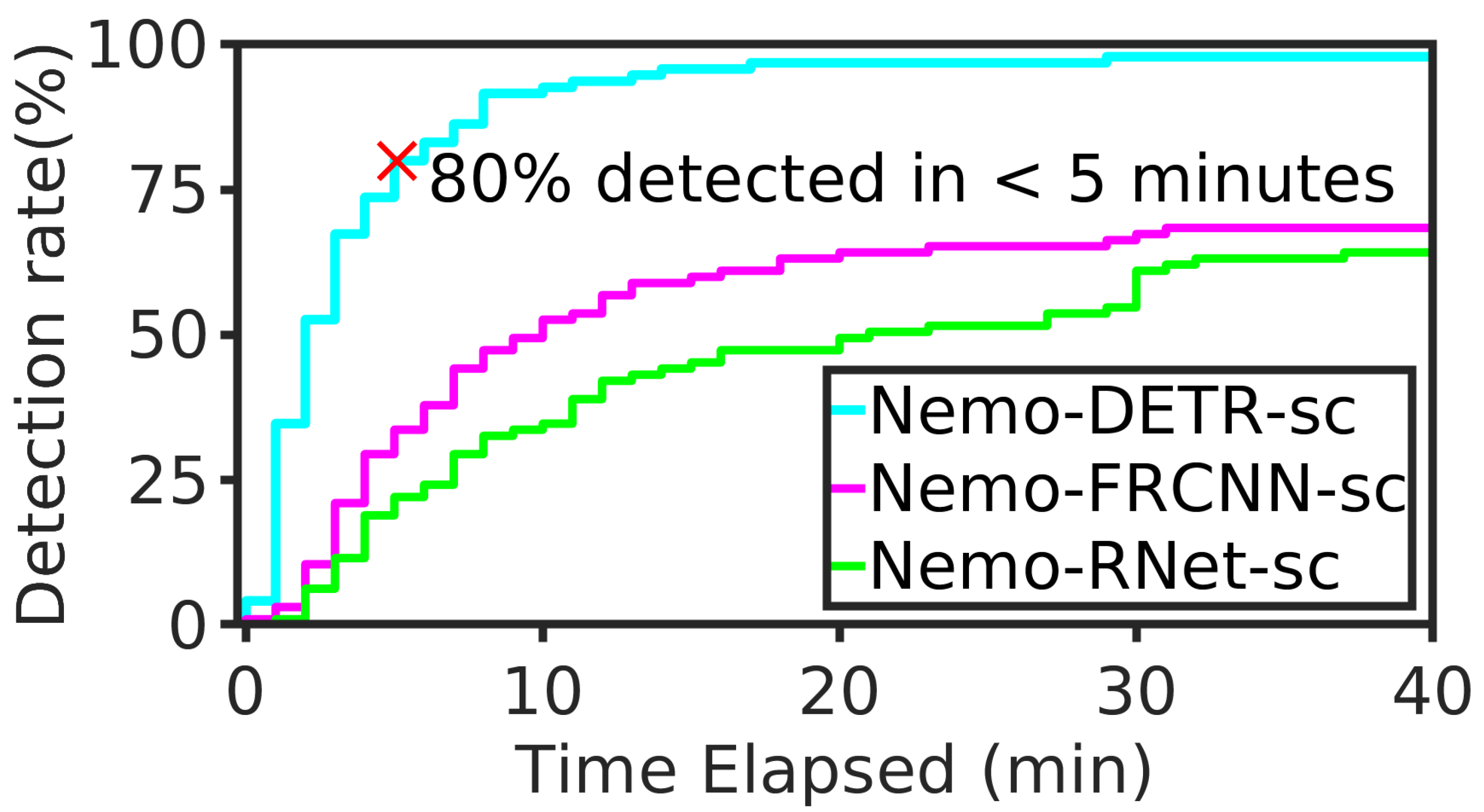


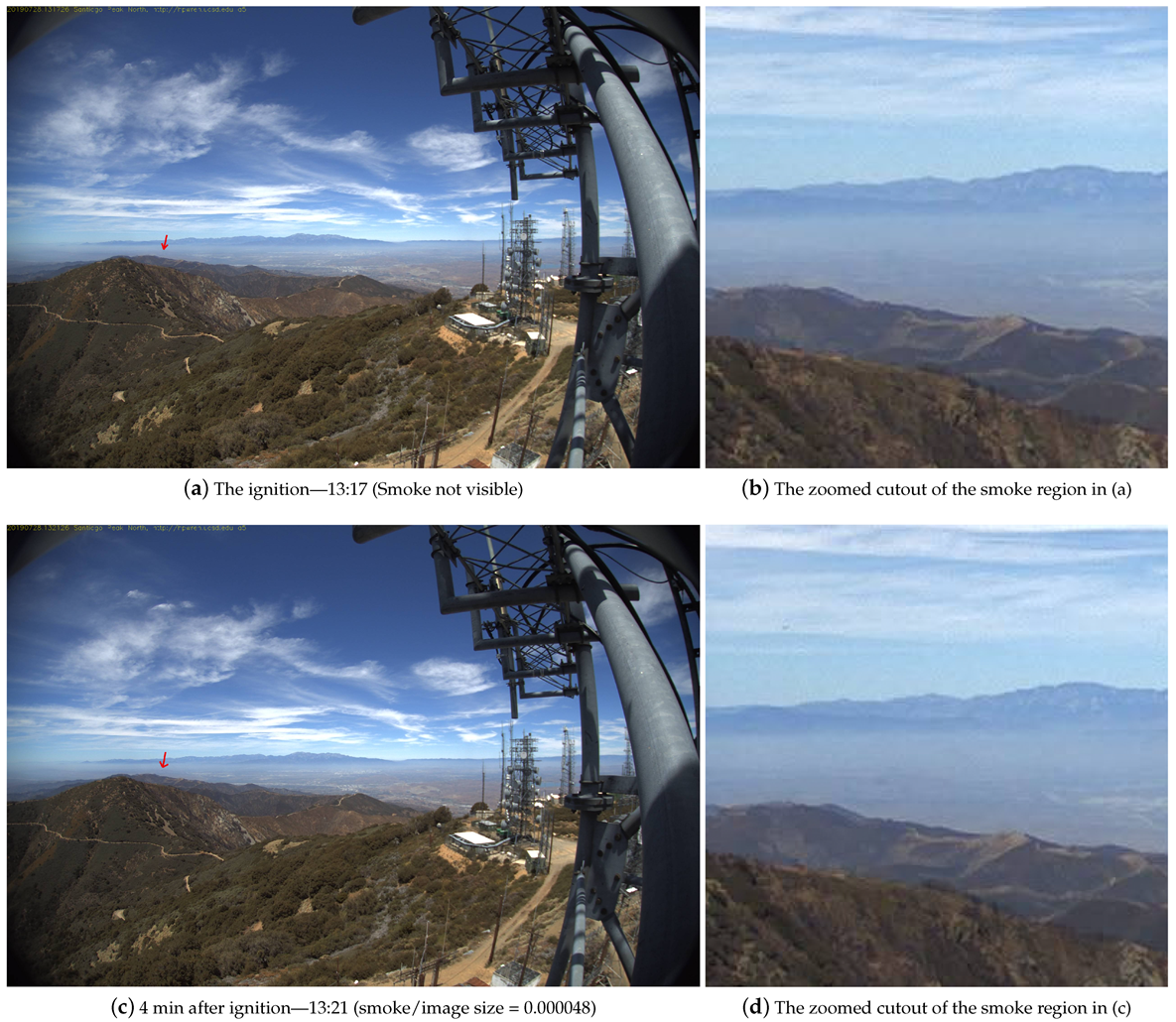
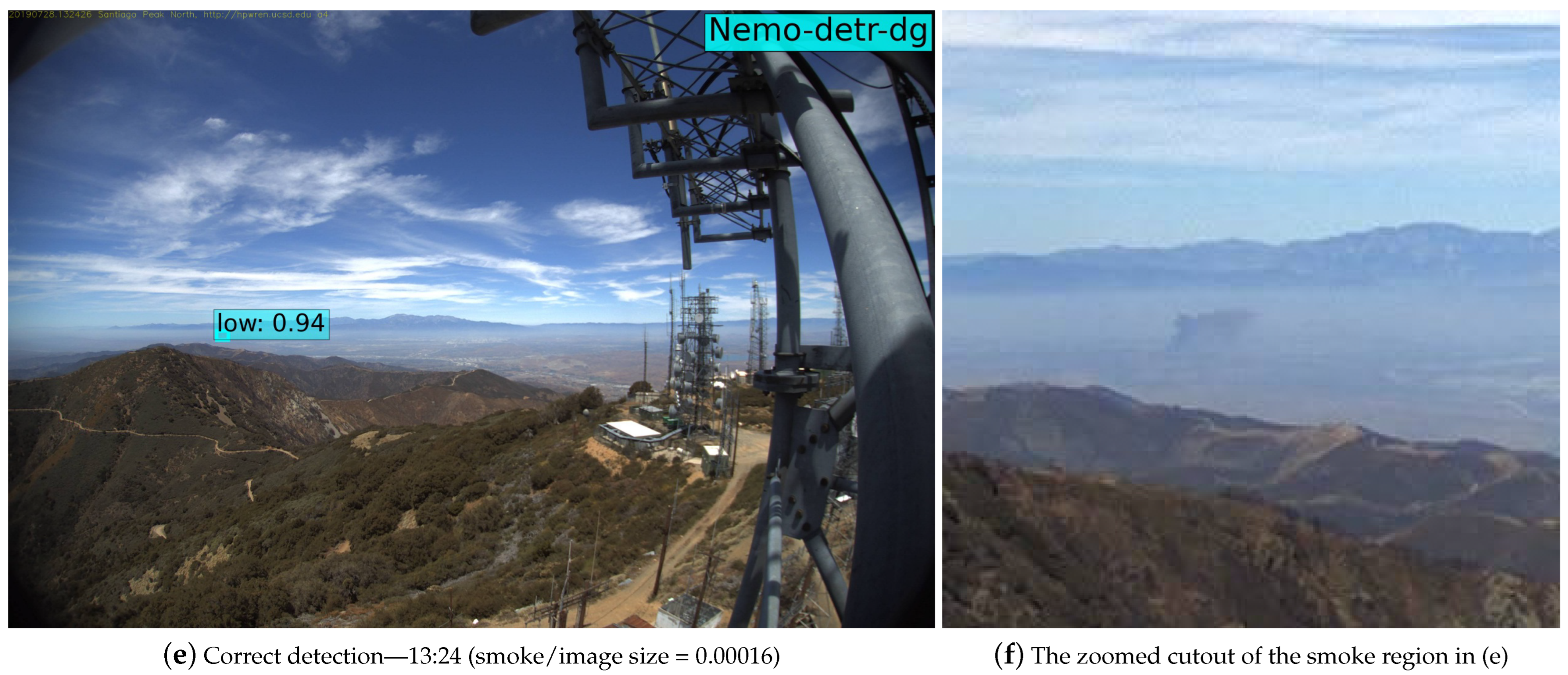


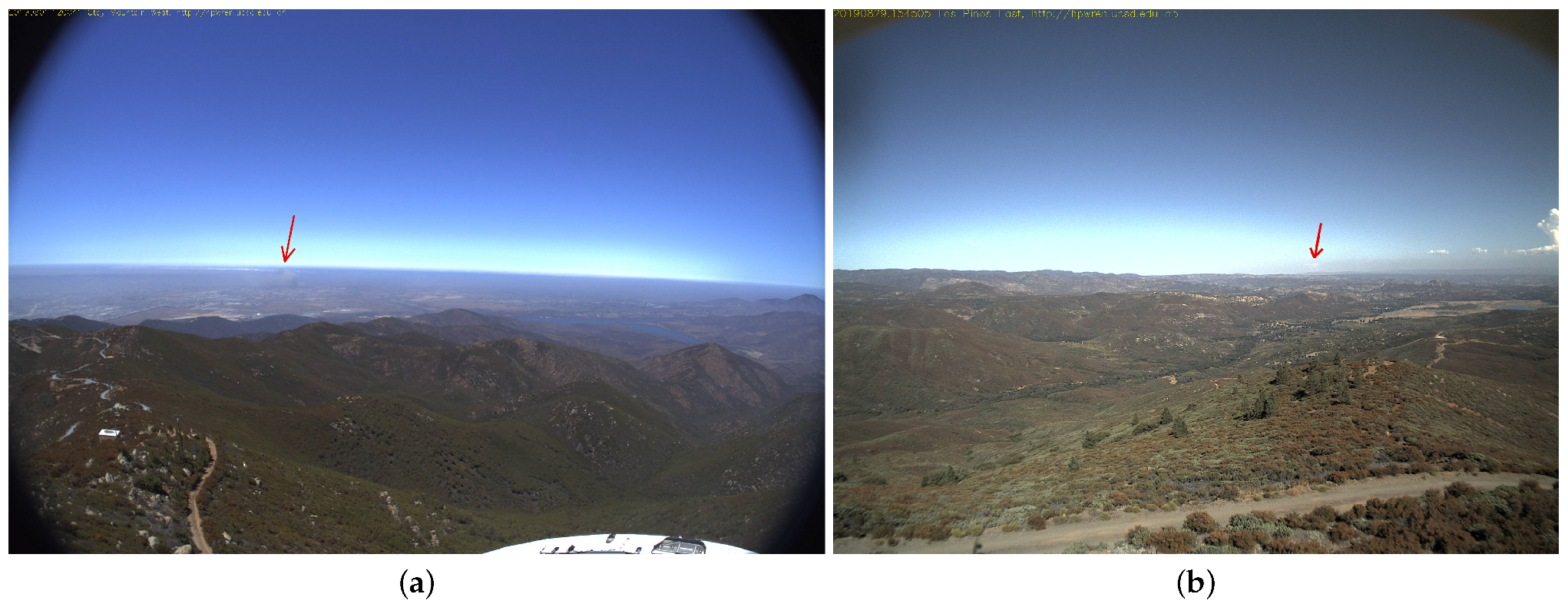
| Ref. | Fire Object | Earliest Stage | Detection Range |
|---|---|---|---|
| [18,19,20,21] | flame | 2 | close |
| [22,23,32,33,34,49,50] | flame, smoke | 2 | close |
| [24,25,26,27] | flame | 1 | medium, close (CCTV) |
| [7,8,9] | smoke | 2 | satellite |
| [28,29,51] | flame | 2 | medium, close |
| [52] | smoke | 2 | close |
| [30,31] | flame, smoke | 1 | medium, close |
| [10] | flame | 1 | medium, close |
| [38] | flame, smoke | 1 | far, medium, close |
| [11,16] | smoke | 1 | horizon, far, medium, close |
| Nemo | smoke | early incipient | horizon, far, medium, close |
| Dataset | Abbv. | #Classes | Dummy Class? | #Smoke Images | #Empty Images | #Collage Images | #Instances |
|---|---|---|---|---|---|---|---|
| Single-class | sc | 1 | N | 2349 | 0 | 0 | 2450 |
| + Empty images | sce | 1 | N | 2349 | 260 | 0 | 2450 |
| Smoke density | d | 3 | N | 2564 | 0 | 0 | 3832 |
| + Collage | dg | 3 | N | 2564 | 0 | 116 | 4254 |
| + Empty images | de | 3 | N | 2564 | 260 | 0 | 3984 |
| + Dummy annotations | dda | 4 | Y | 2564 | 260 | 0 | 4243 |
| + Collage + Empty | dge | 3 | N | 2564 | 260 | 116 | 4254 |
| Model | mAP | AP50 | AP | AP | AP | FPR | FPR |
|---|---|---|---|---|---|---|---|
| Nemo-DETR-sc | 40.6 | 77.2 | 54.4 | 69.4 | 80.7 | 1.2 | 21 |
| Nemo-DETR-d | 13.8 | 34.1 | 35.4 | 28 | 42.3 | 2.4 | 29 |
| Model | #Params | mAP | FPR |
|---|---|---|---|
| DETR | 41M | 42.0 | 20 |
| DETR-DC5 | 41M | 43.3 | 19 |
| DETR-R101 | 60M | 43.5 | 18 |
| DETR-DC5-R101 | 60M | 44.9 | 15 |
| Average Precision (AP) | |
|---|---|
| mAP | Primary challenge metric |
| AP50 | PASCAL VOC metric |
| AP | AP at IoU = 0.33 |
| AP Across Scales: | |
| AP | AP for small objects: area |
| AP | AP for medium objects: area |
| AP | AP for large objects: area |
| Average Recall (AR) | |
| AR | AR at IoU = 0.5 |
| AR Across Scales: | |
| AR | AR for small objects: area |
| AR | AR for medium objects: area |
| AR | AR for large objects: area |
| Model | mAP | AP50 | AP | AP | AP | AP | AR | AR | AR | AR | FA | FPR | F-1 |
|---|---|---|---|---|---|---|---|---|---|---|---|---|---|
| Nemo-DETR-sc | 40.6 | 77.2 | 84.4 | 54.4 | 69.4 | 80.7 | 88.6 | 66.7 | 83.7 | 91 | 96.4 | 21 | 88.7 |
| Nemo-DETR-sc 1 | 41.2 | 76.8 | 91.2 | 58.1 | 64.2 | 81.4 | 85.8 | 77.8 | 77.6 | 88.3 | 98.4 | 26 | 87.7 |
| Nemo-DETR-sce | 42.3 | 79 | 91.2 | 38.6 | 67.6 | 84.1 | 88.6 | 55.6 | 77.6 | 93.1 | 96.8 | 3 | 96.9 |
| Nemo-FRCNN-sc | 29.3 | 68.4 | 86.4 | 27.2 | 64.4 | 72.1 | 77.2 | 44.4 | 75.5 | 79.3 | 84.4 | 36 | 76.6 |
| Nemo-FRCNN-sce | 29.5 | 69.3 | 77.6 | 25.3 | 56.9 | 74.8 | 85.4 | 55.6 | 73.5 | 89.9 | 86.4 | 30 | 79.9 |
| Nemo-RNet-sc | 28.9 | 68.8 | 84.8 | 32.6 | 55.5 | 74.7 | 80.5 | 55.6 | 65.3 | 85.6 | 82.8 | 25 | 79.7 |
| Nemo-RNet-sce | 28.7 | 67.4 | 80 | 9.2 | 65.1 | 71.1 | 78.9 | 33.3 | 73.5 | 82.4 | 71.6 | 19 | 75.1 |
| Model | mAP | AP50 | AP | AP | AP | AP | AR | AR | AR | AR | FA | FPR | F-1 |
|---|---|---|---|---|---|---|---|---|---|---|---|---|---|
| Nemo-DETR-d | 13.8 | 34.1 | 46.1 | 35.4 | 28 | 42.3 | 53.2 | 50.8 | 42.2 | 63.5 | 82.6 | 29 | 78.1 |
| Nemo-DETR-dg | 14.2 | 32.2 | 42.7 | 38.3 | 25.7 | 40.4 | 51.7 | 50.8 | 32.7 | 66.8 | 93.6 | 22 | 79.8 |
| Nemo-DETR-de | 14.1 | 30.8 | 45.5 | 38.7 | 22.9 | 39.7 | 54 | 47.9 | 40.6 | 66 | 82.4 | 0 | 90.35 |
| Nemo-DETR-dge | 13.0 | 27.5 | 42.2 | 42.5 | 19.5 | 33.2 | 43.3 | 44.6 | 27.8 | 54.1 | 76.6 | 2 | 85.8 |
| Nemo-DETR-dda | 12.2 | 29.9 | 45.4 | 41.9 | 30.2 | 31 | 49.9 | 47.5 | 41.4 | 56.5 | 77.6 | 4 | 85.5 |
| Nemo-FRCNN-d | 9.3 | 23.5 | 39 | 15.4 | 25.6 | 26.8 | 48.2 | 19.6 | 41 | 56 | 78.8 | 36 | 73.4 |
| Nemo-FRCNN-dg | 9.9 | 24.3 | 38.8 | 39.4 | 29.3 | 27.8 | 47.9 | 54.2 | 39.1 | 55.4 | 74 | 27 | 73.6 |
| Nemo-FRCNN-de | 9.6 | 24.3 | 36.4 | 51.3 | 26 | 27 | 49 | 63.7 | 35.2 | 57.7 | 72.8 | 10 | 79.65 |
| Nemo-FRCNN-dge | 8.4 | 22 | 34.5 | 35.2 | 23.2 | 23.7 | 48.7 | 57.5 | 39.5 | 54.6 | 74.4 | 17 | 77.7 |
| Nemo-FRCNN-dda | 10.1 | 27.4 | 41.5 | 33.6 | 36.2 | 26.7 | 55.5 | 45 | 47.5 | 62.8 | 68 | 10 | 76.4 |
| Nemo-RNet-d | 9.1 | 20.4 | 31.9 | 13 | 17.1 | 25.8 | 44 | 25.4 | 35.2 | 52.7 | 67.6 | 30 | 68.4 |
| Nemo-RNet-dg | 10.7 | 27.35 | 37.5 | 13 | 25.9 | 34.1 | 53 | 29.2 | 46.8 | 59 | 71.2 | 20 | 74.5 |
| Nemo-RNet-de | 8.8 | 22.6 | 33.1 | 26.6 | 22.8 | 26.4 | 51.5 | 44.2 | 41.6 | 60.9 | 70.8 | 1 | 82.4 |
| Nemo-RNet-dge | 9.55 | 23 | 33.2 | 9.8 | 20.7 | 28.8 | 53.1 | 45 | 43.2 | 60.4 | 65.2 | 6 | 76.17 |
| Nemo-RNet-dda | 9 | 23.1 | 34 | 22.4 | 16.3 | 31.1 | 45.7 | 45 | 31.5 | 58 | 71.6 | 10 | 78.85 |
| Video Name | Ignition Time | Time Elapsed (min) | ||
|---|---|---|---|---|
| Fire21’ [16] | Nemo | |||
| [17] | FRCNN | DETR-dg | DETR-sc | |
| 20190529_94Fire_lp-s-mobo-c | 15:03 | 5 | 1 | 1 |
| 20190610_FIRE_bh-w-mobo-c | 13:22 | 11 | 3 | 4 |
| 20190716_FIRE_bl-s-mobo-c | 12:41 | 23 | 4 | 3 |
| 20190924_FIRE_sm-n-mobo-c | 14:57 | 10 | 3 | 1 |
| 20200611_skyline_lp-n-mobo-c | 11:36 | 12 | 3 | 3 |
| 20200806_SpringsFire_lp-w-mobo-c | 18:33 | 3 | 1 | 1 |
| 20200822_BrattonFire_lp-e-mobo-c | 12:56 | 6 | 2 | 2 |
| 20200905_ValleyFire_lp-n-mobo-c | 14:28 | 6 | 3 | 2 |
| 20160722_FIRE_mw-e-mobo-c | 14:32 | 16 | 10 | 11 |
| 20170520_FIRE_lp-s-iqeye | 11:19 | 3 | 0 | 0 |
| 20170625_BBM_bm-n-mobo | 11:46 | 29 | 9 | 8 |
| 20170708_Whittier_syp-n-mobo-c | 13:37 | 8 | 3 | 3 |
| 20170722_FIRE_so-s-mobo-c | 15:07 | 15 | 2 | 2 |
| 20180504_FIRE_smer-tcs8-mobo-c | 14:33 | 20 | 8 | 8 |
| 20180504_FIRE_smer-tcs10-mobo-c | 15:10 | 4 | 4 | 1 |
| 20180809_FIRE_mg-w-mobo-c | 13:10 | 3 | 0 | 0 |
| + 79 sequences [Table A1] | ||||
| Mean ± sd for 1-16 | 10.8 ± 7.8 | 3.5 ± 3.01 | 3.13 ± 3.18 | |
| Mean ± sd for 95 sequences | 9.1 ± 7.5 | 3.58 ± 4.13 | ||
| #Layers | #Params | mAP | AP50 | AP | AP | AP | AR |
|---|---|---|---|---|---|---|---|
| 0 | 33.4 M | 34.3 | 71.1 | 38.8 | 57.4 | 76.3 | 90.4 |
| 3 | 37.3 M | 39.2 | 77 | 32.2 | 68.1 | 81.3 | 87 |
| 6 | 41.2 M | 40.6 | 77.2 | 54.4 | 69.4 | 80.7 | 88.6 |
Publisher’s Note: MDPI stays neutral with regard to jurisdictional claims in published maps and institutional affiliations. |
© 2022 by the authors. Licensee MDPI, Basel, Switzerland. This article is an open access article distributed under the terms and conditions of the Creative Commons Attribution (CC BY) license (https://creativecommons.org/licenses/by/4.0/).
Share and Cite
Yazdi, A.; Qin, H.; Jordan, C.B.; Yang, L.; Yan, F. Nemo: An Open-Source Transformer-Supercharged Benchmark for Fine-Grained Wildfire Smoke Detection. Remote Sens. 2022, 14, 3979. https://doi.org/10.3390/rs14163979
Yazdi A, Qin H, Jordan CB, Yang L, Yan F. Nemo: An Open-Source Transformer-Supercharged Benchmark for Fine-Grained Wildfire Smoke Detection. Remote Sensing. 2022; 14(16):3979. https://doi.org/10.3390/rs14163979
Chicago/Turabian StyleYazdi, Amirhessam, Heyang Qin, Connor B. Jordan, Lei Yang, and Feng Yan. 2022. "Nemo: An Open-Source Transformer-Supercharged Benchmark for Fine-Grained Wildfire Smoke Detection" Remote Sensing 14, no. 16: 3979. https://doi.org/10.3390/rs14163979
APA StyleYazdi, A., Qin, H., Jordan, C. B., Yang, L., & Yan, F. (2022). Nemo: An Open-Source Transformer-Supercharged Benchmark for Fine-Grained Wildfire Smoke Detection. Remote Sensing, 14(16), 3979. https://doi.org/10.3390/rs14163979






